In the bustling world of commerce, “Consumer Behaviour” is a crucial cornerstone for brands of all sizes. It’s a multi-dimensional science that encapsulates the intricate mix of human actions, motivations, and choices when buying and utilising products and services (introduction to consumer behaviour).
For that reason alone, studying consumer behaviour should be the starting point of any business.
We also discussed and analysed in depth the consumer’s decision-making process, that is, a series of steps (stages) that consumers go through when considering and making purchases of goods and services.
Today, we’re diving even deeper into this beautiful science.
We’ll be discussing the consumer’s involvement with the product.
Consumer’s involvement with the product refers to the level of personal engagement, interest, and significance that an individual attributes to a particular product or product category. It reflects the extent to which a consumer is emotionally, intellectually, and behaviourally connected to the product, influenced by factors like personal relevance, emotional appeal, and perceived importance. Understanding consumer involvement is crucial for businesses seeking to create effective marketing strategies and foster meaningful connections with their target audience.
Are you ready?
Consumer’s Involvement With the Product
Video Overview
Quick Navigation
- Definitions
- Factors that Influence Consumer’s Involvement with the Product
- Involvement Levels
- Comparison of Low – High Involvement Hierarchy
- Categories of Purchasing Behaviour Based on Involvement
- Involvement Measurement
- Psychological Aspects
- Cultural and Social Influences
- Ethical Considerations
- Global Market Insights
- Product Placement and Involvement
- Involvement Theories
- Marketing Strategies for Converting Involvement from Low to High
- Theories of Consumer Learning
- Brand Loyalty
- Technological Advances
- Recent Trends
- Challenges and Pitfalls
- Future Trends
- Statistics
- Real-Life Case Studies
- Implications for Marketing Strategies
- Actionable Takeaways
- Resume
- The Engagement Expert Quiz: How Strong is Your Marketing Game? (and a surprise)
Definitions
Consumer involvement with a product refers to the level of importance and relevance a product holds for an individual.
It can be driven by factors such as self-identity, functional significance, emotional appeal, and group association.
High involvement often entails a strong connection with the product, involving preferences, loyalty, and readiness for action.
Measuring involvement can be done through consumer agreement with specific propositions.
Sensory involvement is a motivational state influenced by situational and internal cues, affecting attention, comprehension, and processing depth.
Involvement theory posits that the consumer follows limited information processing in cases of purchasing products of little involvement or relevance to them. In contrast, the consumer follows extensive information processing in cases of purchasing products of high involvement or relevance to them.
The concept of consumer’s involvement with the product presupposes the following, or combinations of:
- The product is important for the self-identification of the consumer, due to its symbolic importance,
- The product is important because of its functional importance,
- The product can “give birth” to strong attitudes and preferences,
- There are enough differences between product brands to guarantee self-recognition and strong preferences,
- The product has an emotional appeal,
- The product is identified with the rules of the group to which the consumer belongs.
An old study by Kallick, Nearby and Shaffer (ACR, 1974) defined involvement as consisting of the three components of attitudes, namely preference, loyalty and readiness for (purchasing) action.
Kapferer and Laurent (1985) developed a measurement method based on a set of propositions. Consumers state their degree of agreement/disagreement with them, and then with factor analysis, it is possible to derive the consumer’s involvement profile.
This method was tested again by them and by Rodgers and Schneider in 1993, who proposed a modification: merging the “interest and pleasure” dimensions because consumers find it difficult to understand the differences between these two concepts.
Celsi and Olson in 1988 referred to the concept of involvement as sensory (felt) involvement, which they defined as a state of motivation that affects the extent and focus of consumers’ attention, as well as the comprehension processes they follow. Since comprehension processes are affected, it is natural that different meanings for different consumers derive from the same stimuli (eg product features, advertising messages, etc.).
Factors that Influence Consumer’s Involvement With the Product
Consumer involvement with a product is influenced by a variety of factors. Here’s an overview of key factors:
- Personal Relevance: The degree to which a product is personally meaningful and important to the consumer. Products that align with the consumer’s values, self-identity, and lifestyle are more likely to evoke high involvement.
- Functional Importance: Products that serve a critical function in the consumer’s life, such as basic necessities or tools required for daily activities, often trigger high involvement.
- Symbolic Significance: Products that hold symbolic value, representing the consumer’s identity, social status, or group affiliation, can generate high involvement.
- Emotional Appeal: Products that evoke strong emotional responses, such as happiness, nostalgia, or excitement, tend to engage consumers at a deeper level.
- Hedonic Value: The extent to which a product provides pleasure, enjoyment, or sensory satisfaction can impact involvement. Enjoyable or sensory-rich products often command high involvement.
- Brand Importance: The brand’s value and its alignment with the consumer’s self-expression can influence involvement. Well-recognized and respected brands may lead to higher involvement.
- Perceived Risk: The degree to which consumers perceive potential negative consequences or risks associated with the product choice can affect involvement. Higher perceived risk may lead to more involvement in the decision-making process.
- Interest and Passion: A consumer’s inherent interest or passion for a particular product category can increase involvement. Hobbies, interests, or specialised knowledge can heighten involvement.
- Situational and Environmental Cues: Immediate situational factors and environmental cues, such as advertising, recommendations, or point-of-sale displays, can impact involvement by making a product more relevant or appealing.
- Past Experiences: Previous encounters with similar products, brands, or product categories can influence involvement. Positive or negative past experiences may shape consumer involvement.
- Digital and Social Influences: In the digital age, online reviews, social media, and digital experiences can shape consumer involvement. Peer recommendations and online discussions can affect how consumers perceive a product’s relevance.
- Cultural and Societal Influences: Cultural norms, societal trends, and peer group behaviours can affect involvement. A product that aligns with prevailing cultural values may generate higher involvement.
These factors can work individually or interact with one another, depending on the specific context and the consumer’s unique characteristics, resulting in varying levels of involvement with a product. Understanding these factors can be valuable for businesses looking to tailor their marketing strategies and engage consumers more effectively.
Involvement Levels
A consumer’s level of product involvement significantly impacts their information-gathering efforts. High involvement leads to active information collection, while low involvement results in passive exposure.
Consumers encounter product information through various daily activities and advertisements (eg watching television, driving a car, walking down the street, using a mobile phone, etc.).
However, even with exposure to multiple advertising messages, they often acquire limited information about specific product brands. The processing of this information follows a hierarchical pattern, ultimately influencing their purchase decisions.
Comparison of Low – High Involvement Hierarchy
In high involvement, consumers actively learn about attributes, evaluate alternatives, form attitudes, and make purchase decisions. Low involvement relies on passive learning for belief formation, followed by a purchase decision, and possibly an evaluation. These distinct processes categorize consumer behaviour based on product involvement, yielding four purchasing behaviour types.
The figure below shows the differences between the high and low involvement hierarchy.
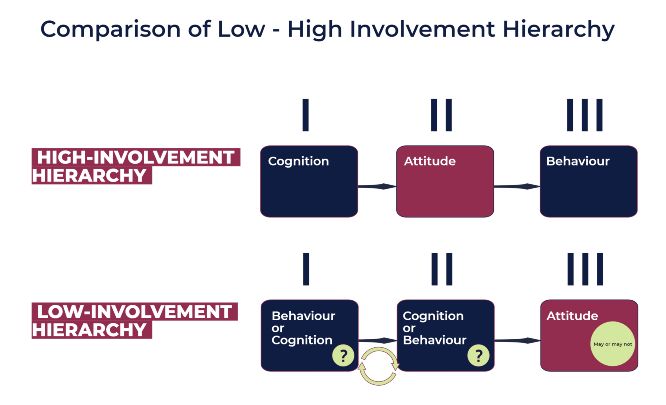
In high involvement, cognitive processes (thinking and evaluating) typically precede the formation of attitudes, which, in turn, influence behaviour.
For low involvement, consumers often act first (behaviour), and then, depending on their experience, they may form attitudes afterwards (based on the post-purchase experience). Cognition (thinking) may come before or after behaviour in low-involvement scenarios.
These hierarchies capture the core principles of involvement-based decision-making.
Categories of Purchasing Behaviour Based on Involvement
1) High involvement and the existence of significant differences between brands:
In this category, consumers are highly involved in the product category, and they perceive significant differences between the brands available. They engage in extensive information processing and careful evaluation.
Here, consumers follow an extended decision-making process (see previous article entitled “Consumer Decision-Making Process”) and may show signs of brand loyalty (in cases of repeat satisfactory purchases).
Example: Consumers shopping for a high-end luxury watch may be highly involved and actively compare brands, considering factors like craftsmanship, brand reputation, and design.
2) High involvement and few differences between brands:
Here, consumers are still highly involved, but they perceive minimal differences among the available brands. They may focus more on personal preferences and emotional connections.
Here, consumers are more likely to engage in efforts to reduce cognitive dissonance, which is the discomfort or tension that arises when individuals hold conflicting beliefs or make choices that challenge their existing attitudes. One way to alleviate this dissonance is by attributing their motives and justifying their decisions.
Example: When choosing between various high-end smartphones, consumers might perceive only marginal differences in performance, making the decision more influenced by personal preferences and brand loyalty.
3) Low involvement and the existence of significant differences between brands:
In this category, consumers have low involvement with the product category, but they perceive significant differences among brands. They may make quick decisions.
Here, consumers are more likely to seek variety and explore different options. When there are noticeable differences between brands, even if the overall involvement with the product is low, consumers may be inclined to experiment with various brands to satisfy their curiosity or to discover what works best for them.
Example: Choosing a basic household cleaning product when you’re not particularly interested in cleaning supplies, but you notice clear differences in price or effectiveness.
4) Low involvement and few differences between brands:
Consumers in this category have low involvement and perceive minimal differences among brands. They might make choices based on convenience or habit.
Here, consumers are more likely to exhibit signs of inertia.
In such situations, consumers may follow a passive decision-making process with little or no active evaluation of brands. This is because when there are few noticeable differences between brands and the consumer has low involvement with the product, there is less motivation to engage in extensive information search or evaluation.
Plus, inertia can lead to brand loyalty when consumers repeatedly purchase the same brand out of convenience or habit.
Example: Selecting a brand of bottled water when you don’t have strong preferences, and all available options seem similar regarding taste and quality.
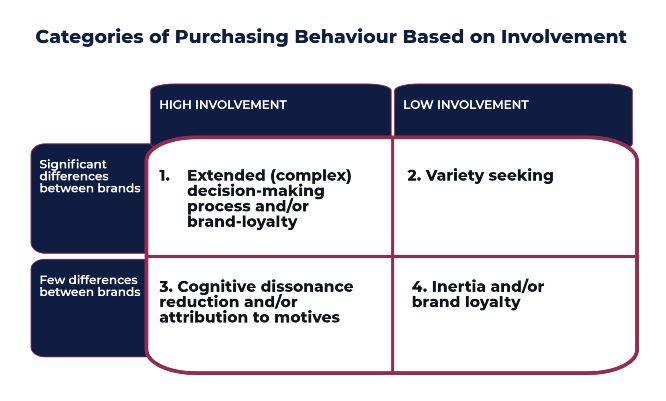
Involvement Measurement
Researchers measure consumer involvement by collecting self-reported data from consumers and exploratory protocols.
- Importance of Measurement: Involvement measurement is crucial for understanding consumer engagement with products and purchase decisions.
- Consumer-Centric Approach: Researchers rely on consumers to provide insights into their engagement levels.
- Quantifying Engagement: Involvement is quantified based on various factors.
- Decision-Making Insights: Measuring involvement reveals consumers’ cognitive and emotional processes during decision-making.
- Marketing Strategy Impact: Measuring involvement guides marketing strategies, helping businesses adapt to consumer engagement levels effectively.
Measuring involvement is essential for understanding consumer behaviour and tailoring marketing efforts accordingly.
In the “7 IDEALS” methodology, I use a variety of consumer reports, exploratory protocols, and tests, as well as data collection and analysis techniques.
Psychological Aspects
Psychological aspects of consumer involvement play a crucial role in understanding how consumers interact with products and brands. Here’s an overview of some key concepts:
- Emotional Involvement: This refers to the consumer’s emotional connection or attachment to a product or brand. When consumers feel emotionally involved, they may have positive feelings, such as love or passion, toward a product or brand. For example, a person who loves a specific brand of coffee because it reminds them of their childhood may be emotionally involved.
- Cognitive Involvement: Cognitive involvement relates to the mental or cognitive aspects of consumer behaviour. It involves how much consumers think about and engage with a product or brand at a rational or intellectual level. Consumers with high cognitive involvement may carefully evaluate product features and benefits before making a purchase decision. In contrast, those with low cognitive involvement may make decisions more impulsively.
- Emotional vs. Cognitive Involvement: These two types of involvement are not mutually exclusive. In fact, they often work in tandem. A consumer may be emotionally involved with a brand, such as feeling nostalgic about a childhood toy, while also considering the cognitive aspects, like the toy’s quality and safety.
- Impact on Consumer Behaviour: Emotional involvement can lead to stronger brand loyalty and a willingness to pay a premium for products associated with positive emotions. For example, consumers might choose a more expensive brand of chocolate because it reminds them of a special moment in their lives. On the other hand, high cognitive involvement can result in more thorough research and comparisons when making purchase decisions.
- Marketing Implications: Understanding emotional and cognitive involvement helps marketers tailor their strategies. For emotionally involved products, evoking positive emotions through advertising, storytelling, or nostalgia can be highly effective. For cognitively involved products, providing detailed product information and comparisons can assist consumers in making informed choices.
- Changing Involvement: Consumer involvement can change over time or due to external factors. For example, a consumer may have low cognitive involvement with everyday products like toothpaste but become highly involved when researching and selecting a new smartphone.
Exploring these psychological aspects of consumer involvement can provide insights into how consumers connect with products and brands on an emotional and intellectual level, ultimately influencing their buying decisions and brand loyalty.
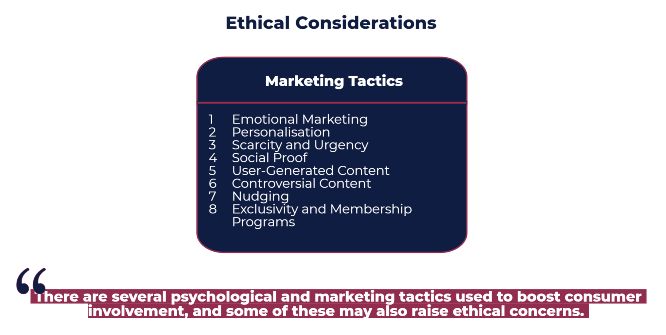
Ethical Considerations
In today’s complex marketing landscape, ethical considerations play a central role in shaping consumer behaviour and defining brand loyalty.
Marketers grapple with moral principles, social expectations, and the need to balance business objectives with responsible practices.
Understanding these ethical dimensions is critical for companies seeking to build strong, lasting relationships with their customers.
This section delves into the ethical aspects of consumer involvement, exploring how they impact marketing strategies and the role of responsible marketing in influencing consumer choices.
There are several psychological and marketing tactics used to boost consumer involvement, and some of these may also raise ethical concerns. Here are a few examples:
- Emotional Marketing: Brands use emotional appeals in their advertising to create a strong connection with consumers. While this can enhance involvement, it may be considered unethical if the emotional manipulation is excessive or deceptive.
- Personalisation: Tailoring marketing messages and product recommendations to individual consumers based on their preferences and behaviours can enhance involvement. However, privacy concerns may arise when collecting and using personal data for these purposes.
- Scarcity and Urgency: Creating a sense of scarcity or urgency can motivate consumers to take immediate action, such as making a purchase. However, ethical concerns may arise if these tactics are overly manipulative or deceptive.
- Social Proof: Using social proof, such as displaying reviews and ratings, can boost involvement by reassuring consumers about their choices. Ethical concerns may arise if fake reviews or testimonials are used.
- User-Generated Content: Encouraging customers to create content related to the brand or product can boost involvement. However, ethical concerns may arise if there’s a lack of transparency about the source of user-generated content.
- Controversial Content: Brands sometimes use controversial or shocking content to grab consumers’ attention. While this can increase involvement, it may also be seen as unethical if it crosses certain boundaries or is offensive.
- Nudging: Nudging refers to subtly influencing consumer behaviour by altering the way choices are presented. It can boost involvement in a desired action but may raise ethical concerns if consumers are pushed into choices that are not in their best interest.
- Exclusivity and Membership Programs: Creating exclusive clubs or membership programs can enhance involvement, but there may be ethical concerns if exclusivity is based on discriminatory criteria.
It’s important for businesses to balance these tactics with ethical considerations and transparency to ensure that consumer involvement is not manipulated in a harmful or deceptive way.
3 Studies
Target Marketing
It’s often considered the pinnacle of marketing and has faced ethical criticism in some cases. Researchers have delved into the ethical concerns and controversies associated with targeting strategies. An empirical study has validated public unease regarding consumer vulnerability and potentially harmful products. It has also pinpointed which targeting approaches are deemed less ethical and raised concerns about the possibility of consumer boycotts and disapproving behaviours. Ethical apprehension becomes more pronounced when both “sin” and “non-sin” products are at play, especially when consumers are perceived as vulnerable.
“Sin” products typically refer to goods or services associated with vices or activities that are considered socially or morally undesirable, such as alcohol, tobacco, gambling, or adult entertainment. These products are often subject to higher levels of regulation and ethical scrutiny due to their potential negative impact on consumers’ health, well-being, or societal values.
In contrast, “non-sin” products are everyday consumer goods or services that do not carry the same ethical concerns or negative connotations. Examples of non-sin products include food, clothing, electronics, or household items. These items are considered less controversial and are typically marketed with fewer ethical issues compared to “sin” products.
Marketing Regulation and Consumer Behaviour: Ethical Issues in Marketing to Children
Marketing ethics encompasses the moral principles underlying marketing operations and regulation. It is a field where marketing intersects with ethical concerns. Some argue that marketing should adhere to moral principles to avoid being considered inherently unethical. This argument is based on three ethical concerns related to marketing:
- Infringement on Personal Autonomy: Marketing can impact the autonomy of intended buyers by influencing their self-determination.
- Harm to Competitors: Fierce competition and unethical marketing tactics, particularly in saturated markets, can harm competitors.
- Manipulation of Social Values: Marketing can promote consumerism and waste, affecting society as a whole.
Three frameworks help analyse marketing ethics:
- Value-Oriented: Evaluates ethical issues based on values like honesty, autonomy, privacy, and transparency.
- Stakeholder-Oriented: Analyses how ethical problems affect different stakeholders, including consumers, competitors, and society.
- Process-Oriented: Examines ethical issues using marketing categories such as research, pricing, and promotion.
These frameworks, while valuable, may not fully categorise the wide range of marketing ethical issues. Ethical concerns also arise in marketing practices targeting vulnerable groups like children and the elderly. Children, for instance, are enticed by products like unhealthy food, fashion items, and entertainment goods. In addition, ethical pitfalls in advertising and promotional content include violence, sex, and controversial content that can trigger public debate and criticism.”
Gamification and Customer Experience in Online Retail: a Qualitative Study Focusing on Ethical Perspective
This study investigates the impact of gamification on consumer engagement in online retail and the ethical concerns related to gamified marketing. It involves qualitative research through interviews with gamification experts. The study identifies themes such as the applicability of gamification in online retail, consumer experiences, and ethical challenges. Interestingly, experts express negative perceptions of ethics in gamification, revealing unethical practices in gamified marketing. The research emphasizes the importance of addressing these ethical concerns to build trust with consumers and retain them as valuable stakeholders in the retail industry.
Gamification is the use of game elements, such as competition, rewards, and challenges, in non-game contexts to engage and motivate people. In marketing, gamified marketing refers to using game-like strategies, often in digital or online platforms, to engage customers, enhance their experiences, and encourage them to interact with brands or make purchases. It leverages elements of game design, like points, badges, leaderboards, or interactive storytelling, to create a more interactive and engaging marketing experience. Gamified marketing can be applied in various ways, such as loyalty programs, contests, interactive ads, or mobile apps, to make marketing efforts more enjoyable and interactive for consumers.
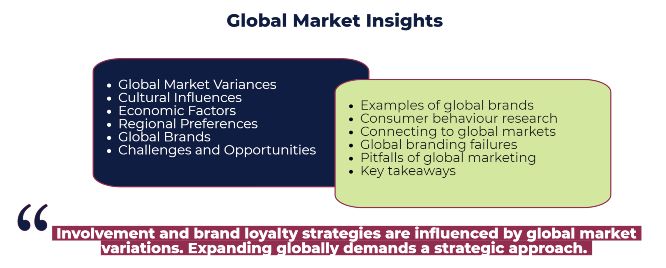
Global Market Insights
Consumer involvement and brand loyalty strategies vary in different global markets.
- Introduction to Global Market Variances: Consumer involvement and brand loyalty strategies can differ significantly across various global markets. These differences can be attributed to cultural, economic, and regional disparities.
- Cultural Influences: Different cultures may have unique approaches to involvement and loyalty. Certain cultural values or traditions affect consumer choices. For instance, the emphasis on family values in some cultures may lead to distinct preferences for certain brands.
- Economic Factors: Economic conditions in different regions can influence consumer involvement. In economically developed markets, consumers may prioritise quality and luxury brands, while price sensitivity might be more significant in emerging markets.
- Regional Preferences: Specific regional preferences or trends affect brand loyalty. For example, consumers in Europe may have different preferences for eco-friendly products compared to those in Asia.
- Global Brands: Global brands maintain a consistent image while adapting to local market nuances. Brands like McDonald’s and Coca-Cola have successfully adapted their menus and marketing campaigns to cater to diverse global tastes.
- Challenges and Opportunities: Challenges and opportunities arise with operating in diverse global markets. Issues like cultural misunderstandings or regulatory hurdles, as well as the potential for expanding brand reach and market share.
Involvement and brand loyalty strategies are influenced by global market variations.
Expanding into new markets, especially globally, demands a strategic approach. Thoroughly researching potential markets is key. Analyse each market, weigh the pros and cons, and consider cultural differences that might impact operations. This groundwork helps identify the best fit for your brand.
Examples of Global Brands:
- Samsung, a South Korean conglomerate, is renowned for global success across industries, thanks to factors like continuous innovation, substantial R&D investments, and a widespread manufacturing presence.
- Alibaba, founded by Jack Ma in China, is a global e-commerce powerhouse with key factors like a global online marketplace, payment solutions via Alipay, and strategic international investments contributing to its success.
- Toyota, a Japanese automaker, leads globally with key factors including quality, efficient production via the Toyota Production System (TPS), and a strong global manufacturing and sales network.
LinkedIn: Case studies and examples of successful international business ventures.
These case studies show that international success necessitates adaptability, a global brand, innovation, and partnerships. Quality and customer satisfaction are key. Aspiring entrepreneurs can find inspiration and insights for their global ventures, knowing that success is achievable with the right strategies and dedication to excellence.
Consumer Behaviour Research:
- This study introduces the A‐B‐C‐D paradigm, a framework for understanding consumer behaviour in global markets. It specifically applies this paradigm to gain insights into consumer behaviour in Eastern Europe and the Third World, offering recommendations for companies seeking to enter these markets.
- Another study reviews 85 peer-reviewed publications on cross-cultural variations in consumer behaviour. It aims to systemise approaches to this research, identify gaps, and offer a research agenda. The review reveals a lack of unified definitions and terminology for cross-cultural research and highlights methodological concerns. It emphasises the concept of cross-cultural variations in consumer behaviour, addressing both differences and similarities. The study provides theoretical and managerial insights.
- Another research article reviews the cross-cultural impact on consumer behaviour, covering aspects such as self, personality, attitudes, motivation, emotions, cognition, and various consumer behaviour domains. It employs the Hofstede model to explain cultural variance and discusses implications for global branding and advertising.”
Connecting to Global Markets – Challenges and Opportunities:
- In this volume, members of the WTO’s academic network in developing countries explore the challenges their countries face in connecting to global markets. Key themes include diversification of exports and the role of small and medium-sized enterprises (SMEs) in global value chains. The study emphasises the need for countries to diversify their exports while maintaining a presence in traditional markets and entering new export areas to achieve sustainable growth.
- Burberry, established in 1856, initially targeted the upper and middle classes successfully by meeting their desire to dress like the upper class. This approach showcased the importance of quality in building brand inventory and loyalty. However, by the early 1990s, consumer preferences had shifted, leading to a decrease in Burberry’s profits. Rose Marie Bravo took over as CEO with the task of rebuilding the brand’s image. She aimed to reposition Burberry from a symbol of social class to a brand accessible to everyone. This involved using balanced communication as a brand-building element.
Global Branding Fails:
When expanding a brand globally, it is essential to ensure that your name, logo, or tagline does not hold unintended meanings in the regions of expansion. Here are a few instances where this critical marketing consideration was overlooked:
Pitfalls of Global Marketing:
Consider the case of Henkel, a prominent West German adhesives manufacturer, in 1982. To revitalise their consumer contact-adhesive brand, Pattex, they aimed to expand it to include new products in growing market segments. However, this approach faced strong opposition from Henkel’s global subsidiaries, with doubts and concerns about its feasibility.
A study of 17 cases involving global marketing standardisation at American and European multinationals found that nine ventures succeeded, while eight failed to meet their objectives. This study highlights the critical role of decision-making processes in determining outcomes. The research identifies five common pitfalls affecting global marketing programs and leading to suboptimal performance or failure.
These pitfalls encompass inadequate use of formal research, over-standardisation, inadequate follow-up, limited program coordination, and inflexible implementation.
Key Takeaways:
In conclusion, the insights gathered from various studies and case examples provide a valuable understanding of the complexities and opportunities within the global market landscape.
These findings underscore the importance of adaptability to local markets, the significance of a strong global brand, the role of innovation, and the potential benefits of strategic partnerships.
Moreover, they emphasize the unyielding commitment to quality and customer satisfaction as a common thread among successful global companies. Aspiring international entrepreneurs can draw inspiration from these examples as they embark on their own global business journeys, equipped with the knowledge that international success is indeed achievable with the right strategies and dedication to excellence.
The lessons from these studies and cases serve as a compass for navigating the multifaceted world of global markets and shaping a path toward growth and prosperity.
Product Placement and Involvement
In marketing, product placement (positioning) strategies vary based on consumer involvement levels. Low-involvement products are positioned as problem solvers, addressing consumer needs. High-involvement products focus on maximising benefits for consumers seeking the most value.
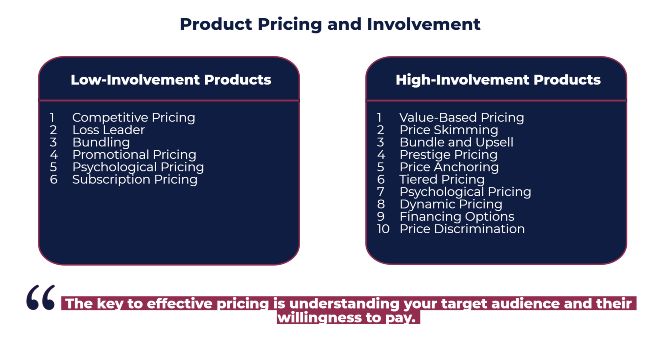
Product Pricing and Involvement
Effective pricing strategies can vary for low-involvement and high-involvement products due to differences in consumer behaviour and the decision-making process.
In cases of low consumer involvement, price reductions and discount offers can be effective strategies to influence consumer preferences.
However, in high-involvement scenarios, price is just one of many factors, and consumers often consider multiple product characteristics. In such cases, the price-quality relationship plays a role in determining brand quality.
This reflects the way consumer involvement affects the significance of pricing strategies.
Here are some pricing strategies that work well for each category:
For Low-Involvement Products:
- Competitive Pricing: Since low-involvement products are often seen as commodities, competitive pricing is crucial. Brands should price their products in line with or slightly below the competition to attract cost-conscious consumers.
- Loss Leader: Some low-involvement products can serve as loss leaders, where brands sell them at a loss or minimal profit to attract customers to their store or website. Once in, consumers may make additional, more profitable purchases.
- Bundling: Bundle low-involvement products together or with higher-margin items to encourage upselling and boost the overall transaction value. For example, offering a discount on a snack when purchased with a drink.
- Promotional Pricing: Running periodic promotions, such as buy-one-get-one-free or limited-time discounts, can stimulate impulse purchases. Clearance sales and seasonal discounts can also be effective.
- Psychological Pricing: Use pricing techniques that appeal to consumer psychology. For example, pricing products at $9.99 instead of $10 can create a perception of a better deal.
- Subscription Pricing: For consumable low-involvement products, offer subscription services where consumers receive regular deliveries at a discounted price. This creates loyalty and repeat purchases.
For High-Involvement Products:
- Value-Based Pricing: High-involvement products should be priced based on the perceived value they provide to the consumer. Emphasize the benefits, features, and quality to justify a higher price point.
- Price Skimming: Introduce high-involvement products at a premium price and gradually lower the price over time as demand matures. This strategy is effective when there’s initial demand for a unique or innovative product.
- Bundle and Upsell: For high-involvement products, bundle related items or offer extended warranties, maintenance plans, or premium customer support to justify a higher price.
- Prestige Pricing: Position the product as a luxury or premium item and set the price higher to appeal to a specific target market seeking exclusivity.
- Price Anchoring: Present a high anchor price (the original price) alongside a lower sale price to make the lower price appear more appealing. This can be particularly effective during sales events.
- Tiered Pricing: Offer multiple versions of a product, each with varying features and price points. This allows customers to choose the option that best suits their needs and budget.
- Psychological Pricing: Similar to low-involvement products, use psychological pricing strategies to create perceptions of value. This can include “odd pricing” (e.g., $999 instead of $1,000) or emphasizing savings.
- Dynamic Pricing: Adjust prices based on real-time market conditions, demand, and individual customer behaviour. This is more common in online retail and eCommerce.
- Financing Options: Offer financing or installment payment plans for high-involvement products to make them more affordable over time.
- Price Discrimination: Tailor prices to different market segments. For example, charging higher prices for business customers who may place larger orders or require specialised services.
The key to effective pricing is understanding your target audience and their willingness to pay. Brands should continuously monitor market dynamics, consumer preferences, and competitors to adapt their pricing strategies to changing conditions.
Both low and high-involvement products benefit from clear, transparent pricing that aligns with consumer expectations.
Product Display/Promotion and Involvement
Product display and promotion strategies are influenced by the level of consumer involvement with a product. This distinction is particularly evident in both traditional and online advertising approaches.
High-Involvement Products:
In the case of high-involvement products, advertising aims to persuade consumers by providing detailed information and evidence of the product’s benefits. Online channels play a significant role, with content that reinforces the product’s value and quality. High-involvement consumers pay close attention to these messages.
Low-Involvement Products:
For low-involvement products, advertising focuses on creating consumer awareness and familiarity, often through repeated messages. Online advertising, especially on platforms like social media, is used to maximise product exposure. Messages emphasize key features and use visual elements, avoiding lengthy text. Sales promotion techniques, such as special offers, remain essential to encourage repeat purchases.
These advertising strategies align with consumer involvement levels, ensuring that the marketing approach complements the product’s significance to the consumer.
By incorporating online advertising channels, businesses can reach a wider audience and tailor their messages to different levels of consumer involvement.
Related research by Laczniac and Muehling (1993) showed that the consumer’s involvement with the advertising message affects the evaluation of the characteristics of the various brands of the product, their attitude towards the advertisement, as well as the degree of confidence they have in their judgment.
Additionally, support was found by the same research for the theory that the strength of a consumer’s product evaluation is not affected by their level of involvement with the product. But especially for high product involvement consumers, it has been argued that brand evaluations by them are made with more certainty than brand evaluations by low involvement consumers.
The same greater certainty characterises the attitude toward advertising of highly involved consumers. Contrary to what was previously unquestioned, consumer involvement with the advertising message has been found to directly affect their attitude toward the ad.
In the very message-dense environment we live in, the consumer’s involvement along with the attention they give to them play an important role in how effective the messages are.
Pratkanis and Greenworld in 1993 found that consumers who have high involvement with a product pay more attention to information about that product, especially when they have to solve the purchase problem soon.
Similar to the previous study (Celuch and Slama, 1993) it was shown that the television programs in which the advertisements are shown determine the effectiveness of the messages. Specifically, television advertising messages are effective when there is harmony/congruence between the source of engagement with the ad (cognitive or affective) and the source of engagement with the television program in which the particular ad appeared.
Examples
-The Hewlett Packard portable “DeskJet” printer is a highly mixed product because of its high price, being a durable product, and its use is important to the consumer. The importance of use is emphasized in the related advertisement with the slogan “With the new portable deskjet printer from Hewlett-Packard, every space is my office”. The quality and speed of printing, the ease of portability, the many programs it accepts, and the fact that it is silent are on display.
-Similar is the advertisement of Toshiba notebooks with the slogan “When you reach the top, the details count”. The advertisement presents in detail the technical characteristics of the product.
-Nikon camera advertising aims to present a high-involvement product (relatively expensive, important in terms of photo quality, etc.) as affordable. The ad emphasizes that it is now offered at new, reduced prices and that thus acquiring a Nikon ceases to be a wish, it becomes a reality for professional and amateur photographers. Another Nikon ad tries to simplify the consumer’s important high-involvement product decision with the tagline “Pros want them because they know, amateurs because they don’t need to know.”
-An advertisement for an Audi car model, the “wild version” touts its power (125 hp, 1,600 cc), high value (all extras, ABS, air conditioning, aluminium wheels, power steering, fog lights, electric windows and mirrors ). The Opel X advertisement presents in great detail its characteristics (1400i and 1200i, aerodynamic, catalytic, reliable, comfortable, impressive, etc., what it has on the outside, on the inside, even under the hood, what kind of watch has, and so on).
-The advertisement for the Saab X presents this car as a “reasonable passion” with a central benefit for its user being the safety it offers (one of the key features of this product that consumers at the brand selection stage take very seriously). To support the safety that Saab offers, the ad shows the relevant details (ABS, driver and passenger airbags, rear wipers, headlight wipers, and more).
-The Nissan X ad goes into a lot of detail about the car’s technical features and suggests: “Compare it to what’s considered perfect.” It is therefore presented as “Perfect in performance, in comfort, and in quality”.
-The Fiat X advertisement presents in detail the information concerning the safety, comfort, equipment, guarantees, and financing of its purchase.
-Company X’s electric cookers, washing machines and dishwashers, and refrigerators are advertised with the slogan “Nikos and Zoe love good food, change clothes every day, never wash dishes by hand, and prefer their coffee with ice cubes”. The conveniences offered by these products are mainly highlighted (washing, automatic water quantity calculation, hot-cold, quiet, fast, economical, built-in, luxury, the refrigerator does not need to be defrosted, takes out water and ice cubes, etc.). These products are high-involvement because of their price, and because the person who buys them expects them to last for many years. So the decision to buy them is important and must be taken seriously and with enough thought. Company X’s ad presents these products together because it is mainly aimed at young couples who are in the decision stage of furnishing their home, and who usually buy all these types of equipment at the same time. This is a serious decision and of course a big investment.
-The X (expensive, precious) jewellery ad is another example of high-involvement advertising. The ad features no text (unlike classic high-involvement ads), just a photo of a diamond necklace and earring set.
-The advertisement of Salt X (a product generally considered to be of low involvement) is trying to gain the attention of the consumer. It does not emphasize its price or its taste, but its quality, and above all what it offers to Hellas (for example, the first meat industry in Hellas, purely Hellenic, with invested capital of 35 million euros, exports, closes only the sea and the sun of Hellas). In another ad, the same Salt X presents its quality by promoting its different types and packaging, but here its central slogan is “Sun and sea – smack blessed.”
-The advertisement for Conditioner X highlights the product’s features (ease of use, ease of rinsing, that it disappears in six to eight washes, does not contain ammonia and peroxide of hydrogen, and offers intense and bright highlights). Similar are the ads for provitamin shampoo and styling products of company X. The products of the X series “Beautiful hair is the signature.”
-Ads for milk portions or coffee creamers are examples of low-involvement ads. The texts of such advertisements are limited. In their advertising X portions only use the slogan “Coffee tastes better with X portions”, while Y uses the slogan “Every moment has its own portion in the enjoyment of coffee” explaining that it offers servings of whole milk, partially skimmed, and cream.
-The X beer ad, like most beer brands, relies on very simple messages, without presenting any details about the product. Company X uses the simple slogan “Because this is the way you like it.”
-The ad for the can of X tuna in water highlights its 103 calories, with the slogan “Eliminate the calorie stress”. The ad also features a big competition with 100 exercise bikes – which further reinforces the product’s low-calorie appeal.
-“The purest, softest touches in the world” is the main slogan of the various types of X brand cotton. Medical cotton and cotton sticks of the X brand are presented in their three types.
- High-Involvement – Apple’s “1984” Ad: Apple’s iconic Super Bowl commercial, which introduced the Macintosh computer, is a classic example of a high-involvement product ad. It used imagery and messaging to emphasize the groundbreaking nature of the product.
- High-Involvement – Nike’s “Dream Crazy” Ad: This ad featuring Colin Kaepernick is a high-involvement product promotion. It sparked significant public discussion and demonstrated the brand’s values.
- High-Involvement – BMW’s “The Hire” Series: BMW’s series of short films, including “Star” with Clive Owen, emphasize the quality, luxury, and performance of the brand’s vehicles.
- Low-Involvement – Old Spice’s “The Man Your Man Could Smell Like”: This humorous and memorable campaign became a viral sensation and is a prime example of effective low-involvement product advertising.
- Low-Involvement – Dollar Shave Club’s “Our Blades Are F*ing Great”:** This quirky ad used humour and a clear value proposition to attract attention.
- Low-Involvement – Geico’s “Hump Day” Commercial: Geico’s humorous “Hump Day” ad became a cultural phenomenon, even though it was promoting an insurance service.
Most Used Ad Channels
Brands use a variety of channels to display and promote their products. The choice of channels often depends on the target audience, the nature of the product, and the marketing goals. Here are some of the most commonly used channels for product promotion:
- Social Media Marketing: Platforms like Facebook, Instagram, Twitter, and LinkedIn are widely used for product promotion. Brands create engaging content, run paid advertising campaigns, and leverage influencer marketing on these platforms.
- Search Engine Marketing (SEM): Pay-Per-Click (PPC) advertising on search engines like Google is an effective way to promote products, especially for eCommerce businesses.
- Content Marketing: Brands create valuable content in the form of blog posts, videos, infographics, and more to educate and engage their target audience.
- Email Marketing: Email campaigns are used to reach existing customers and prospects with product updates, promotions, and newsletters.
- Influencer Marketing: Collaborating with influencers in relevant niches helps brands reach a broader audience and build trust with their recommendations.
- Affiliate Marketing: Brands partner with affiliates who promote their products in exchange for a commission on sales generated through their efforts.
- eCommerce Platforms: Businesses with online stores leverage eCommerce platforms like Amazon, eBay, and Shopify to showcase and sell their products.
- Video Marketing: Video-sharing platforms like YouTube are essential for brands to create product demos, tutorials, and engaging video content.
- Public Relations (PR): Press releases and media outreach help generate buzz around new product launches and major announcements.
- Print and Display Advertising: Traditional advertising methods like print ads, billboards, and direct mail are still used by many brands, depending on their target audience.
- Event Marketing: Hosting or participating in events, trade shows, and expos provides opportunities to showcase products to a live audience.
- Mobile Marketing: Brands optimize their websites and marketing materials for mobile devices, as mobile usage continues to grow.
- Chatbots and Messaging Apps: Brands use chatbots and messaging apps to interact with customers and provide product information and support.
- Content Sharing Platforms: Visual platforms like Pinterest and Snapchat allow brands to share product images and connect with users.
- Podcast Advertising: As podcast popularity grows, advertising on podcasts is a valuable channel to promote products and services.
- Guerrilla Marketing: An effective and attention-grabbing marketing strategy for some brands. Guerrilla Marketing is characterised by unconventional, creative, and often low-cost tactics to promote products or services. It’s designed to make a big impact with a limited budget. Some examples of Guerrilla Marketing include flash mobs, public stunts, street art, and other creative, unexpected approaches to capture the audience’s attention. In the “7 IDEALS” methodology, we use both traditional and unconventional techniques, depending on the brand, and its goals, the product, the situation, and the target audience.
Please note that the digital marketing landscape is continuously evolving, so you need to stay up to date with the latest marketing and consumer behaviour trends to choose the most effective channels for your specific products and target audience.
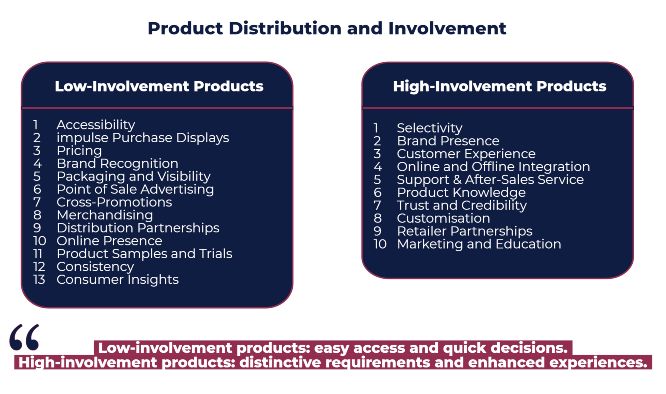
Product Distribution and Involvement
Distribution strategies vary based on product involvement levels.
For low-involvement products, broad distribution is essential because consumers typically don’t actively seek out specific brands. Brands should be readily available in multiple stores, with prominent in-store placement, and the use of signage and advertising to serve as reminders and influence purchase decisions.
For the distribution of low-involvement products, where consumers typically engage in minimal decision-making, several factors are essential in addition to broad distribution. Here are some key considerations:
- Accessibility: The products should be readily accessible to consumers. This means being available in a wide range of retail locations, including grocery stores, convenience stores, online marketplaces, and other high-traffic areas. Accessibility ensures consumers can easily encounter and purchase the product during their routine activities.
- Impulse Purchase Displays: Low-involvement products often benefit from strategically placed impulse purchase displays near checkout counters. Eye-catching displays and placement can prompt last-minute purchases as consumers wait in line to complete their transactions.
- Pricing: Competitive pricing is crucial for low-involvement products. Consumers are less likely to deliberate on price when buying such products, so offering an attractive price point can lead to quick purchasing decisions.
- Brand Recognition: Brands with strong recognition and loyalty are more likely to succeed with low-involvement products. Familiarity with the brand can influence consumer choices when they are faced with multiple options in-store.
- Packaging and Visibility: Packaging should be designed to catch the consumer’s attention quickly. Bold colours, clear labelling, and easily recognisable packaging can make the product stand out on shelves.
- Point of Sale Advertising: Point-of-sale advertising, including posters, banners, and brochures, can help communicate product benefits and create awareness among consumers who may not have previously considered the product.
- Cross-Promotions: Partnering with complementary products or services can be effective. For example, placing a low-involvement snack product near beverages or offering bundle deals can encourage additional purchases.
- Merchandising: Effective merchandising practices, such as ensuring that the product is placed at eye level, can increase visibility and convenience for consumers.
- Distribution Partnerships: Collaborating with distributors and retailers to optimise product placement and logistics is crucial. Brands should work with distribution partners to ensure that low-involvement products are consistently stocked and replenished.
- Online Presence: In today’s digital age, having a strong online presence is important even for low-involvement products. eCommerce platforms and online marketplaces can expand the reach of these products, providing consumers with easy access and convenient ordering options.
- Product Samples and Trials: Offering product samples or trials in-store can encourage consumers to try low-involvement products, increasing the likelihood of repeat purchases.
- Consistency: Consistency in product quality and availability is vital. Consumers expect the same product experience each time they purchase a low-involvement item, reinforcing their trust in the brand.
- Consumer Insights: Brands should continuously gather and analyse consumer insights and preferences to adapt their distribution strategies to changing market conditions and consumer behaviours.
By focusing on these factors, brands can maximize the distribution of low-involvement products and create an environment where consumers can easily access and make quick decisions about these items.
For high-involvement products, distribution strategies need to align with the more considered and thoughtful decision-making process typically associated with these products. Here are some factors that are essential for the distribution of high-involvement products:
- Selectivity: High-involvement products may require a more selective distribution approach. Brands should carefully choose retail outlets that match the product’s positioning and cater to the target market. Exclusive or speciality stores can be particularly effective.
- Brand Presence: High-involvement products benefit from having a strong brand presence in the selected retail locations. This includes attractive displays, well-trained sales staff, and branded materials that communicate product benefits.
- Customer Experience: Consumers of high-involvement products often seek a personalized and immersive shopping experience. Retailers should focus on providing excellent customer service, expert guidance, and opportunities for consumers to interact with and experience the product.
- Online and Offline Integration: An effective distribution strategy for high-involvement products may involve a blend of online and offline channels. Brands should ensure their products are available through eCommerce platforms while maintaining a presence in brick-and-mortar stores.
- Support and After-sales Service: High-involvement products often come with the expectation of comprehensive support and after-sales service. Brands should have mechanisms in place to assist customers with product setup, maintenance, and addressing any issues that may arise.
- Product Knowledge: Sales staff should be well-versed in the technical and functional aspects of high-involvement products. They should be able to answer customer questions and provide guidance to help consumers make informed decisions.
- Trust and Credibility: Building trust is crucial when selling high-involvement products. Brands should focus on transparency, warranties, and testimonials to assure consumers of the product’s quality and reliability.
- Customisation: High-involvement products may benefit from customisation options. Brands should consider offering variations or add-on features that allow consumers to tailor the product to their specific needs and preferences.
- Retailer Partnerships: Partnerships with reputable retailers or specialised dealers can enhance the distribution of high-involvement products. Collaborating with retailers known for quality and customer service can boost consumer confidence.
- Marketing and Education: In-store or online marketing materials should be informative and persuasive. Brands should invest in educating consumers about the product’s unique features, benefits, and how it meets their specific needs.
By addressing these factors, brands can create a distribution strategy that caters to the distinctive requirements of high-involvement products and enhances the overall consumer experience.
Involvement Theories
There are various theories that help us unravel the complex interplay between consumer involvement levels and the impact of advertising on purchasing decisions.
- Passive Learning Theory (Krugman, 1965): This is primarily applicable to low-involvement products, where consumers often learn about these products through passive exposure to advertising or marketing messages. Consumers don’t actively seek information but are rather influenced by advertising messages on TV, radio, or the Internet. For low-involvement products, consumers may not deeply engage with product information but may make purchase decisions based on the simple recognition of a product’s existence and its associated benefits. This theory is characterised by the notion that consumers can be influenced by repetitive exposure and familiarity with a product.
- Social Crisis Theory (Sherif, 1965): This helps differentiate between high and low involvement in consumer decision-making. Sherif’s theory introduces the concepts of “latitude of acceptance,” “latitude of rejection,” and “latitude of non-commitment” in the context of consumer attitudes. In situations of high product involvement, consumers have a limited range of acceptable brands or products, leading to a small latitude of acceptance. Conversely, low product involvement results in a broader range of acceptable options, resulting in a larger latitude of acceptance. High-involvement consumers tend to use a larger number of product attributes when making decisions, while low-involvement consumers rely on fewer attributes. This theory emphasizes the role of assimilation (positive meaning) in high-involvement situations and contrast (negative meaning) in low-involvement scenarios when consumers encounter messages or information that align or disagree with their existing attitudes.
- Elaboration Likelihood Model (ELM): Developed by Petty and Cacioppo, this model suggests that consumers can process information in two ways, either centrally (high involvement) or peripherally (low involvement). It emphasizes the role of motivation and ability in influencing the depth of information processing.
- Hoch and Ha’s Elaboration Likelihood Model for High-Involvement and Low-Involvement Products: This model extends the ELM and incorporates product involvement. It suggests that high-involvement products are more likely to be processed centrally, while low-involvement products are processed peripherally.
- Consumer Involvement Profile (CIP): This model categorises consumers based on their levels of involvement and decision-making styles. It distinguishes between high, moderate, and low involvement and provides insights into how different consumer segments approach product decisions.
- Multiattribute Models: These models, like the Theory of Reasoned Action (TRA) and the Theory of Planned Behavior (TPB), take into account a range of factors that influence consumer decisions, including attitudes, social norms, and perceived behavioural control.
- Flow Theory: This theory focuses on consumer experiences and suggests that individuals may become highly involved in an activity or product when it offers a state of flow—intense focus and enjoyment.
- Experiential and Informational Processing: Some theories emphasize experiential (emotional) processing over informational (rational) processing in understanding consumer responses. This could be relevant in the context of high-involvement products where emotions play a significant role.
Now, we can better understand how consumer behaviour and product involvement can be influenced by passive learning and the way attitudes are formed and processed based on involvement levels.
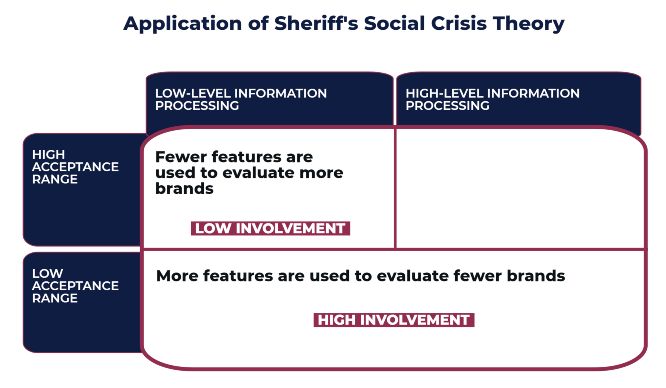
Marketing Strategies for Converting Involvement from Low to High
In marketing, there are several effective approaches to shape consumer behaviour and encourage greater engagement with products.
With the help of appropriate changes in the elements of the marketing mix, a firm can pursue specific strategies in order to convert consumers in one of its target markets from low-involvement consumers with the product to high-involvement consumers.
This would have the effect of increasing the preference for the brand promoted by the company and offers several valuable benefits for businesses:
- Increased Brand Loyalty: High-involvement consumers are more likely to develop emotional connections with a brand, fostering loyalty and repeat business.
- Enhanced Brand Recognition: As consumers become more engaged with a product, they are more likely to remember the brand and its unique attributes, leading to increased brand awareness.
- Potential for Higher Sales: When customers are highly involved with a product, they are more willing to explore and purchase related offerings, leading to increased cross-selling and upselling opportunities.
- Greater Customer Satisfaction: High-involvement consumers are more likely to be satisfied with their purchases as they have invested time and thought into their decisions, resulting in fewer regrets and returns.
- Word-of-Mouth Marketing: Highly involved customers are more likely to share their positive experiences with others, leading to organic word-of-mouth marketing and brand advocacy.
- Competitive Advantage: A brand that successfully converts low-involvement customers into highly involved ones gains a competitive edge by creating stronger relationships and customer retention.
- Market Differentiation: The process of increasing involvement can help a brand stand out in a crowded marketplace by highlighting unique selling points and fostering a distinct brand identity.
These benefits underscore the importance of engaging consumers and guiding them towards higher involvement to build stronger and more profitable customer relationships.
In an upcoming workshop, we’ll expand upon the conversion subject and I will reveal various marketing strategies that you can apply immediately to your business. So, stay tuned!
Theories of Consumer Learning
In general, learning is defined as any relatively permanent change in human behaviour that occurs as a result of experience, practice, repetition, training, or observation. There are many theories that explain how learning occurs, that is, how this change in a person’s behaviour occurs. These theories are of particular interest to marketing since its efforts – functions are aimed at changing or maintaining the behaviour of certain categories of consumers.
Several notable theories provide insights into consumer behaviour:
- Thorndike’s Stimulus-Response Theory (1965): Learning involves forming connections between sensory inputs and behavioural responses.
- Watson’s Theory: Learning creates habits through stimulus-response associations.
- Cognitive Learning Theories: These theories emphasize cognitive processes and the restructuring of individuals’ data to solve problems.
- Tolman’s Theory: Combines aspects of associative and cognitive theories, introducing the role of perception and beliefs in shaping responses.
- Skinner’s Theory: Focuses on behaviour modification through rewards and punishment.
- Classical Association Theory (Pavlov): Learning involves the association of stimuli. For example, repetitive exposure to advertising can associate a neutral stimulus with a specific response.
- Associative Learning in Advertising (Stuart et al, 1987): Consumer attitudes toward brands are formed through associative learning.
- Linking Processes and Attention (Janiszewski and Warlop, 1993): Successful associations can capture a consumer’s attention and encourage information gathering.
- Knowledge Acquisition in Children (Peracchio, 1992): Younger children can learn effectively through simplified and structured information presentation.
An Experiment
In classical association theory, stimuli create learned connections. For instance, Cigarettes X, as an unconditioned stimulus, elicits a response in smokers. When paired with unrelated stimuli, like a cowboy image, through repetition, a connected response emerges. This associative learning is harnessed by marketers to shape consumer attitudes toward their products, often through subtle, unconscious connections.
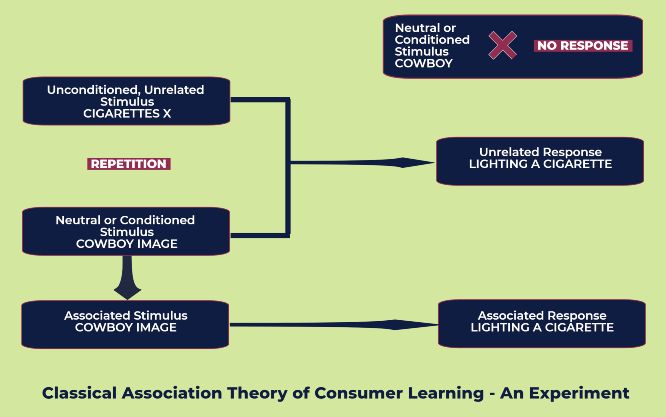
Brand Loyalty
Brand loyalty can exist in buying situations as shown in the table below:
- Continuous brand loyalty
- Brand loyalty/occasional switching
- Brand loyalty/switching
- Split brand loyalty
- Brand indifference
| Brand Purchase History of the Product Category | Order in which Brands were Purchased |
| Continuous brand loyalty | A A A A A A A A A A |
| Brand loyalty/occasional switching | A A A B A A C A A D |
| Brand loyalty/switching | A A A A A B B B B B |
| Split brand loyalty | A A B A B B A A B B |
| Brand indifference | A B C D E F G H I J |
Now, here’s the question, is it possible that purchasing behaviour alone is an indication of brand loyalty?
Recent research on brand loyalty has unveiled two essential components that define a consumer’s loyalty to a brand:
- A favourable attitude toward the specific brand.
- Consistent, systematic purchases of the same brand over an extended period.
Relying solely on the repetitive purchase of a single brand is insufficient to gauge loyalty. For instance, a consumer might consistently opt for the cheapest available brand in a store. This purchasing pattern does not necessarily signify brand loyalty; it may merely reflect a cost-driven choice. The consumer’s loyalty can shift if they find a more economical alternative in the same store.
To assess brand loyalty, researchers often employ stochastic models, akin to learning curves. These models estimate the likelihood of repeat purchases based on the number of previous purchases within a specific timeframe. Additionally, deterministic models predict consumer behaviour—such as brand selection—by considering individual characteristics, attitudes toward different brands, and consumer needs.
Behavioural methods for measuring brand loyalty in a specific consumer category rely on Panel Data Studies, where consumers self-report their purchases. They meticulously record their buying decisions, enabling researchers to delve into loyalty patterns.
Moreover, Lawrence has delved into potential consumer reactions after switching brands.
The consumer may switch again to the new brand and return to the original brand (reversion), remain committed to the new brand (conversion), continue to randomly switch purchases between the new brand and the original brand (vacillation), and continue to try other brands, i.e. changes brands beyond new and original.
Cognitive methods of studying the consumer committed to a brand have identified its main characteristics.
The brand-loyal consumer:
- is more likely to be influenced by reference groups
- is more sure of their choice
- belongs to higher income groups (lower-income consumers prefer deals although higher-income consumers may compare more brands in order to reduce monetary risk
- has a higher level of risk perception and
- it is more likely that they are also committed to a store from which they buy the brand they prefer.
In frequently purchased product categories, heightened brand advertising prompts consumers to increase their purchases of a specific brand and product (Raj 1982). Interestingly, when consumers switch from their current brands to the advertised brand, there is relatively little alteration in their preferences. Raj’s research also unveiled that the effectiveness of advertising hinges on the degree of consumer loyalty (attachment) to a brand. Thus, it may not be advantageous for a brand with a relatively modest core of loyal buyers to mimic the advertising strategy of a brand with a more extensive consumer base.
A 1989 survey by Dow Jones and Co. Inc., as documented in Schiffman and Kanuk’s 1994 book, demonstrates that the extent of brand loyalty fluctuates based on the product category. Notably, categories like cigarettes (71%), mayonnaise (65%), toothpaste (61%), coffee (58%), painkillers (56%), film (56%), and soaps (53%) exhibit the highest brand loyalty percentages. Conversely, product categories such as batteries (29%), sports shoes (27%), and canned vegetables (25%) record lower loyalty and adherence rates. Furthermore, it is essential to acknowledge that recent years have witnessed a further decline in loyalty rates across numerous product categories, primarily attributed to the proliferation of private labels.
Factors Affecting Brand Loyalty
Brand loyalty is influenced by various factors, including:
- Product Quality and Consistency: Brands that consistently deliver high-quality products tend to have more loyal customers. Consumers trust brands that meet or exceed their expectations.
- Brand Reputation: A brand’s reputation, built over time through positive customer experiences and reviews, plays a significant role in fostering loyalty.
- Customer Satisfaction: Satisfied customers are more likely to become loyal. When a brand consistently meets their needs and provides excellent customer service, loyalty is strengthened.
- Price and Value: While low prices can attract customers, it’s the perceived value of the product or service that ultimately impacts loyalty. Customers are willing to pay more for products they believe offer great value.
- Brand Trust: Trust is crucial for brand loyalty. Customers need to trust that the brand will fulfill its promises and provide a positive experience.
- Emotional Connection: Brands that evoke positive emotions and resonate with customers on a personal level tend to create stronger loyalty. Emotional branding can be a powerful tool.
- Convenience and Accessibility: Easy access to products and services, whether through physical stores or online channels, contributes to brand loyalty.
- Innovation: Brands that continuously innovate and offer new and improved products or services can maintain customer interest and loyalty.
- Customer Engagement: Brands that engage with customers through various touchpoints, such as social media, email marketing, and loyalty programs, can foster stronger relationships.
- Competitive Landscape: The competitive environment can impact brand loyalty. Customers may switch brands if they find better options elsewhere.
- Global, Cultural and Social Factors: Cultural and social trends, as well as peer influence, can affect brand loyalty. Customers may be drawn to brands aligned with their values or popular among their social circles. Brand loyalty may differ across various cultures and markets.
- Brand Loyalty Programs: Loyalty programs, offering rewards, discounts, or exclusive benefits to repeat customers, can significantly influence brand loyalty.
- Brand Image and Identity: A brand’s image, including its logo, slogan, and overall identity, can create a sense of belonging and recognition among customers, strengthening loyalty.
These factors interact and vary across industries and product categories. Successful brands understand these dynamics and work to cultivate and maintain strong brand loyalty through strategic marketing and customer engagement efforts.
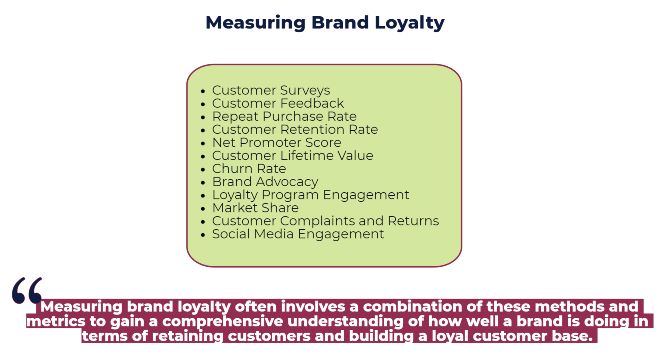
Measuring Brand Loyalty
Measuring brand loyalty is essential for brands to assess how well they are retaining and satisfying their customer base. There are several methods and metrics used to gauge brand loyalty, including:
- Customer Surveys: Brands often use surveys to directly ask customers about their loyalty and satisfaction. Questions may cover aspects like the likelihood of repurchasing, recommending the brand to others, or switching to a competitor.
- Customer Feedback: Monitoring feedback from customers, including online reviews, social media comments, and direct messages, can provide insights into brand loyalty. Positive feedback and recommendations often indicate loyalty.
- Repeat Purchase Rate: This metric calculates the percentage of customers who repeatedly buy from the brand. A high repeat purchase rate is a strong indicator of brand loyalty.
- Customer Retention Rate: This measures the percentage of customers retained over a specified period. A higher retention rate indicates stronger loyalty.
- Net Promoter Score (NPS): NPS is based on the question, “How likely is it that you would recommend our brand to a friend or colleague?” Customers are categorized as promoters (loyal), passives, or detractors based on their responses.
- Customer Lifetime Value (CLV): CLV calculates the total value a customer is expected to bring to a brand over their lifetime. Loyal customers tend to have a higher CLV.
- Churn Rate: The churn rate measures the percentage of customers who stop purchasing from the brand. A lower churn rate signifies greater loyalty.
- Brand Advocacy: Brands can measure advocacy by tracking the number of customers actively promoting the brand to others through word-of-mouth, social media, or reviews.
- Loyalty Program Engagement: For brands with loyalty programs, tracking how actively customers engage with these programs can be an indicator of loyalty.
- Market Share: Gaining or maintaining market share can suggest that a brand is successfully retaining customers and even attracting new ones.
- Customer Complaints and Returns: A low number of complaints and returns can indicate a high level of brand loyalty, as loyal customers are less likely to express dissatisfaction or return products.
- Social Media Engagement: Monitoring engagement metrics like likes, shares, comments, and followers on social media platforms can provide insights into customer loyalty and brand advocacy.
Measuring brand loyalty often involves a combination of these methods and metrics to gain a comprehensive understanding of how well a brand is doing in terms of retaining customers and building a loyal customer base. These measurements can guide marketing and customer retention strategies.
Technological Advances
Augmented Reality (AR)
Augmented reality blends the physical and digital worlds, creating interactive experiences. AR applications, such as AR try-on features for clothing, furniture, or cosmetics, enhance consumer involvement by allowing them to visualise products in their real environment before making a purchase.
Example: Brands like IKEA have leveraged AR by offering customers the ability to virtually place furniture in their homes through an AR app, providing an engaging shopping experience.
Since its introduction in 2017, this revolutionary app has achieved remarkable results. It has led to a 20% decrease in product returns and a substantial 35% boost in online sales. IKEA Place, by delivering an immersive and true-to-scale experience, empowers customers to make well-informed choices while shopping online.
Virtual Reality (VR)
Virtual reality immerses consumers in a completely digital environment. VR can transform consumer involvement by offering virtual product demos, tours, or experiences, which can enhance brand loyalty.
Example: Audi provides a compelling instance of VR training. Given the intricacies of their work involving complex systems, errors are frequent. To address this, the automaker is harnessing virtual reality to minimise the occurrence of errors.
Audi is currently developing a software development kit (SDK) that enables various departments to generate their own training modules without necessitating any programming knowledge. Conventional instructions like “remove the part,” “tighten the screw,” and “insert the part” can be associated with diverse scenarios.
Artificial Intelligence (AI)
AI technologies, including chatbots and personalised recommendations, can tailor the consumer experience. AI-driven personalisation can increase consumer involvement by offering relevant content and assistance.
Example: Brands like Amazon utilise AI algorithms to provide personalised product recommendations, increasing customer involvement and encouraging repeat purchases.
Amazon pioneered personalised product recommendations using their “item-based collaborative filtering” algorithm. This algorithm tailors each customer’s homepage based on their interests and past purchases, making it unique. As described in the Semantics Scholar article “Two Decades of Recommender Systems at Amazon.com”:
“Amazon.com has been building a store for every customer. Each person who visits Amazon.com experiences a personalised store, where items of interest move to the forefront, creating a store that rearranges its shelves as you browse, ensuring relevant products are prominently displayed.”
Case Study: Sephora
Sephora’s latest app update introduces the Sephora Virtual Artist feature, leveraging facial recognition for virtual lip shade trials and in-app purchases. With a substantial online following and the ability to simplify the search for the perfect lipstick shade, this augmented reality addition is poised to boost sales through strategic promotion via the app, email, text, social media, and traditional marketing channels.
Sephora SEA adopted a precise approach for their campaign, focusing on users who recently viewed makeup product pages but hadn’t used VA. To evaluate the campaign, 20% of this group was kept as a control. The process involved:
- Sending a push notification and Content Card with a makeup tutorial video to the targeted users.
- Following up with an In-App Message (IAM) for users who engaged with the Content Cards.
- Deep linking users to VA when they clicked on the IAM for an interactive experience.
Case Study by Braze: Sephora SEA Increases Augmented Reality Feature Adoption Rates by 28%.
Case Study: Lowe’s
Early results indicate that VR and AR tools at Lowe’s serve two primary purposes: aiding customers in understanding tool usage and product compatibility with their homes and accelerating employee training for more personalised customer support.
Trained employees contribute to a more expert in-store experience. Data from the company reveals that VR-trained employees are 76% more likely to use machinery, while customers have a 42% higher recall rate compared to YouTube how-to videos when using VR tools.
DigiDay: Lowe’s is using VR and AR to get people into stores.
Case Study: Netflix
Netflix’s AI functions by:
- Tracking your viewing habits, including what you watch, how long you watch it, and whether you finish a show or movie.
- Identifying your preferences, such as genres, themes, and preferred actors.
- Rating shows and movies based on factors like popularity, user ratings, and alignment with your taste.
- Creating a personalised list of recommendations for you.
Netflix employs advanced machine learning algorithms to analyse data, detect patterns, and uncover trends in user behaviour, which would be difficult for humans to discern. Factors taken into account for recommendations include your viewing history, watch duration, completion rate, ratings, and what other users with similar preferences have watched. The more you watch, the smarter Netflix’s AI becomes at suggesting content tailored to your preferences.
Recent Trends
We should always study recent trends carefully before shaping our marketing strategies. Here are the latest consumer trends related to involvement:
- Health and Wellness: Consumers are increasingly focused on health and wellness, which includes seeking products and brands that promote physical and mental well-being. Brands that align with these values and offer health-related products are likely to see increased consumer involvement.
- Local and Sustainable Sourcing: The trend towards supporting local businesses and sustainable sourcing practices has gained momentum. Consumers are more involved with brands that prioritise these values, promoting a sense of community and environmental responsibility.
- Ethical Supply Chains: Consumers are concerned about the ethical treatment of workers and sourcing practices. Brands that ensure ethical supply chains and transparent production methods can build stronger involvement with socially conscious consumers.
- Diversity and Inclusion: Brands that champion diversity and inclusion in their marketing, products, and company culture are likely to connect more deeply with consumers who value these principles.
- Circular Economy: The concept of a circular economy, which focuses on reducing waste and promoting product recycling and upcycling, is gaining importance. Brands that embrace this approach can foster involvement among environmentally conscious consumers.
- Mental Health and Well-being: Given the growing awareness of mental health, brands that support mental well-being and stress reduction are resonating with consumers. Products and services that address mental health concerns are gaining involvement.
- Brand Transparency: Transparency in business practices, ingredient sourcing, and corporate responsibility is a key trend. Brands that openly communicate their values and actions can build trust and involvement with consumers.
- Sustainable Packaging: Packaging that is eco-friendly, recyclable, or biodegradable is an emerging trend. Brands that minimise packaging waste and environmental impact can boost involvement.
- DIY and Customisation: Consumers are showing interest in do-it-yourself (DIY) projects and personalised products. Brands that offer customisation options and support consumers’ creative endeavours can enhance involvement.
- Well-being Tech: Technology that focuses on improving mental and physical well-being, such as meditation apps, fitness wearables, and sleep trackers, is becoming more popular. Brands that embrace these technologies can engage consumers interested in self-improvement.
These are the factors that shape contemporary consumer behaviour.
Moreover, do take a look at the recent trends related to the consumer decision-making process that I mentioned in the previous article and analysed in depth in my book.
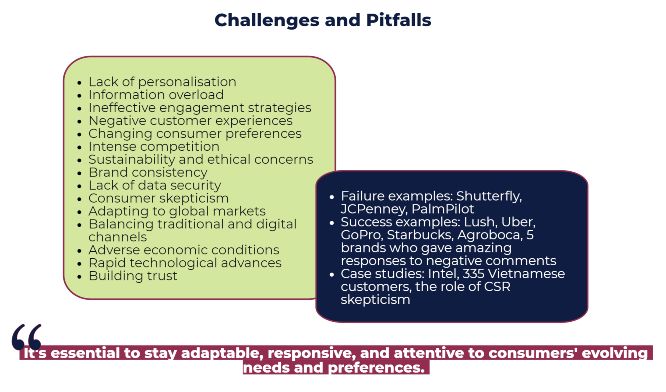
Challenges and Pitfalls
Brands often encounter several common challenges and pitfalls when striving to increase consumer involvement and foster brand loyalty. Here are some of these challenges and strategies to overcome them:
- Lack of Personalisation: Challenge – Treating all customers the same can hinder efforts to engage them. Overcoming – Personalise marketing messages, offers, and experiences based on consumer data and preferences.
- Information Overload: Challenge – Bombarding consumers with excessive information can overwhelm them. Overcoming – Streamline communication, offering digestible and relevant content.
- Ineffective Engagement Strategies: Challenge – Failing to engage consumers through the right channels and methods. Overcoming – Understand your audience’s preferences and create engagement strategies that cater to them.
- Negative Customer Experiences: Challenge – A single bad experience can lead to brand disloyalty. Overcoming – Prioritise exceptional customer service and respond effectively to negative feedback.
- Changing Consumer Preferences: Challenge – Consumer preferences evolve, and brands must adapt. Overcoming – Continuously gather consumer insights, monitor trends, and be agile in modifying strategies.
- Intense Competition: Challenge – Stiff competition can make it hard to stand out. Overcoming – Develop a unique value proposition and focus on what sets your brand apart.
- Sustainability and Ethical Concerns: Challenge – Consumers increasingly value sustainability and ethical practices. Overcoming – Adopt eco-friendly and ethical practices, and communicate these commitments transparently.
- Brand Consistency: Challenge – Inconsistent branding and messaging can confuse and deter consumers. Overcoming – Ensure a unified brand identity and messaging across all touchpoints.
- Lack of Data Security: Challenge – Concerns about data security can deter consumers from engaging. Overcoming – Invest in robust data security measures and inform consumers of your commitment to protecting their information.
- Consumer Skepticism: Challenge – Modern consumers are skeptical of marketing. Overcoming – Be transparent and authentic in your messaging, addressing consumers’ skepticism.
- Adapting to Global Markets: Challenge – Expanding globally requires understanding diverse markets. Overcoming – Conduct thorough market research, engage with local experts, and adapt strategies to the cultural context.
- Balancing Traditional and Digital Channels: Challenge – Striking the right balance between traditional and digital marketing can be tricky. Overcoming – Identify the channels most preferred by your target audience and allocate resources accordingly.
- Adverse Economic Conditions: Challenge – Economic downturns can affect consumer spending. Overcoming – Diversify offerings, offer promotions, and focus on added value during economic challenges.
- Rapid Technological Advances: Challenge – Keeping up with technology can be challenging. Overcoming – Invest in technology that enhances consumer experiences and keeps your brand competitive.
- Building Trust: Challenge – Earning and maintaining consumer trust is crucial for loyalty. Overcoming – Consistently deliver on promises, prioritise transparency, and actively engage with customers.
Brands that can effectively address these challenges and pitfalls are better positioned to foster consumer involvement and build lasting brand loyalty. It’s essential to stay adaptable, responsive, and attentive to consumers’ evolving needs and preferences.
Failure Examples
- Shutterfly: Inaccurate personalisation can lead to PR nightmares, and automated marketing personalisation, if not carefully implemented, poses risks. Shutterfly’s mishap serves as an example when an email congratulating customers on a new baby reached those struggling with infertility, highlighting the importance of precision in automated messaging.
- JCPenney: In late 2011, struggling JCPenney hired a new CEO, Ron Johnson, known for his innovative retail work at Target and Apple. He aimed to reinvent JCPenney’s shopping experience, but it ultimately failed. The failure wasn’t due to bad ideas; some consumers may have liked the changes, such as offering everyday low prices and making stores a social space. The issue was that these changes didn’t align with JCPenney’s core audience, who enjoyed hunting for deals with coupons. JCPenney’s mistake was assuming what customers wanted instead of truly understanding them. They could have listened and made minor adjustments, but instead, they strayed from their core brand ideals, alienating many consumers.
- PlamPilot: The original Palm Pilot PDA, released in 1997, sold a million units in its first year and can’t be considered a failure. However, Palm’s inability to transition from this success into a smartphone empire is a major tech tragedy. Acquired by HP in 2010, Palm has since struggled, and it’s currently owned by TCL, which also owns BlackBerry.
Success Examples
- Lush: Lush is a dedicated advocate for ethical and eco-friendly cosmetics. They use natural, ethically sourced ingredients free from harmful chemicals, focusing on both quality and environmental responsibility. Lush excels in innovative packaging solutions, from plastic-free options to recyclable and recycled materials. They are leaders in reducing waste and minimising environmental impact. Their environmental commitment extends to supporting non-profits and campaigns for conservation, animal welfare, and human rights, exemplified by their Charity Pot program. Lush’s stores are immersive spaces designed to inspire change, and they empower consumers with information about ingredients and product impact, promoting ethical consumerism.
- Uber: Uber’s fare reward system multiplies fares based on local demand and driver positioning. It uses regression analysis to identify busy areas and adjusts fares to attract more drivers. Uber’s algorithms continuously track real-time driving conditions, distances, and GPS data for fare calculations, making it adaptable to local needs. Similar models are used by hotel chains and airlines but differ from Uber’s real-time demand estimation. Uber employs RADAR, an AI system for fraud detection and prevention. It identifies anomalies and generates rules based on collected data to stop future frauds. Unfair practices result in account deletion.
- GoPro: GoPro, a popular action camera seller, combines digital advertising with real-world presence. Their “Be a Hero” campaign encouraged customers to share videos about heroism. They also sponsored events and used outdoor ads to create a strong in-person presence. This strategy keeps GoPro top-of-mind for potential action camera buyers, both online and in physical stores.
- Starbucks: Despite closing around 900 locations at the start of the 2009 financial crisis, Starbucks not only rebounded but thrived during both recessions. Key factors in their success include: 1) Innovation and diversification: Starbucks introduced loyalty programs and mobile payments during the 2009 crisis, boosting customer engagement and sales. 2) Employee investment: Instead of layoffs, Starbucks maintained benefits and perks like healthcare and stock options, retaining top talent and a strong company culture. 3) Market expansion: Starbucks continued opening new locations, especially in China, at a rapid rate, requiring precise localisation and international marketing efforts.
- Agroboca: Create a clear purpose and mission statement to build brand trust. Check if your mission statement is prominently displayed on your website and clear to consumers. Make it easy for people to understand your business’s purpose and values. Incorporate your values into your marketing strategies and actions. Example: Agroboca effectively communicates its mission through an explainer video that highlights the importance for consumers to purchase fruits and vegetables directly from the growers and what they gain by using the Agroboca platform, thus connecting with consumers who support their values.
- 5 Brands Who Gave Amazing Responses to Negative Tweets
Case Studies
- Intel’s War on Information Overload: This report delves into the daily challenges faced by knowledge workers, including information sources and interruptions. It also outlines Intel’s initiatives to address the resulting issues of information overload and reduced productivity.
- 335 Vietnamese Customers’ Responses: This study explores negative customer engagement and its cognitive dimension in an emerging market. Using the Critical Incident Technique, 335 Vietnamese customers’ responses to negative service incidents were examined. The findings identified various unfavourable cognitive responses, including perceptions of injustice, incompetence, irresponsibility, distrust, and cynicism, which interact within a complex system. This research is the first to empirically investigate the cognitive dimension of negative customer engagement in an emerging market and a commercial service context. Negative customer engagement can have detrimental effects on well-being, society, and the economy. Understanding the cognitive triggers can help managers design effective service recovery strategies, particularly in emerging markets.
- When consumers doubt, Watch out! The role of CSR skepticism: Corporate social responsibility (CSR) is a key management topic, but consumer skepticism is growing due to numerous CSR claims and corporate misconduct reports. This study, based on attribution theory, explains how consumer skepticism toward grocery retailers’ CSR develops and its impact. Egoistic and stakeholder-driven attributions increase skepticism, while values-driven attributions reduce it. CSR skepticism negatively affects retailer equity, increases resistance to negative information, and encourages unfavourable word of mouth.
Future Trends
This is a tough task. Let’s predict the future.
The future of consumer involvement is likely to be shaped by various factors, including technological advancements, evolving consumer behaviours, and changing market dynamics. Here are some insights and predictions:
- AI-Powered Personalisation: Artificial intelligence and machine learning will play a pivotal role in enhancing personalisation. Brands will use AI algorithms to analyse vast amounts of data and deliver highly customised experiences, from product recommendations to content tailored to individual preferences.
- Immersive Technologies: Virtual reality (VR) and augmented reality (AR) will continue to impact consumer involvement. Brands may leverage these technologies for interactive product demonstrations, virtual showrooms, and enhanced customer experiences.
- Voice Commerce and IoT: Voice-activated devices and the Internet of Things (IoT) will offer new opportunities for consumer engagement. Customers may make purchases, seek information, and interact with brands through voice commands, requiring businesses to optimise their strategies for voice search and assistance.
- Sustainability and Ethical Practices: Increasing awareness of environmental and ethical concerns will drive consumer involvement. Brands that embrace sustainability, ethical sourcing, and corporate social responsibility are likely to earn consumer loyalty.
- Rise of Social Commerce: Social media platforms will continue to blur the lines between social interactions and commerce. Consumers can shop directly through social media, and brands will need to adapt their strategies to leverage this trend effectively.
- Data Privacy and Security: With growing concerns about data privacy, consumers will demand more transparency and control over their data. Brands that prioritise data security and ethical data usage will earn trust and involvement.
- Convenience and Seamless Experiences: As consumers seek convenience, brands will focus on frictionless shopping experiences. Features like one-click purchasing, fast delivery, and seamless returns will become standard.
- Content-Driven Engagement: Content marketing will remain a key strategy for consumer involvement. Brands will need to create valuable, informative, and entertaining content to engage with their audiences.
- User-Generated Content: Encouraging users to create content related to the brand will continue to be a powerful involvement tactic. User-generated content builds trust and authenticity.
- Globalisation and Local Relevance: Global brands will adapt to local markets while maintaining a consistent global image. Localisation and understanding of cultural nuances will be crucial for successful consumer involvement in diverse regions.
- Sensory Branding: Brands will increasingly explore multisensory experiences, integrating touch, smell, and sound into their marketing efforts to create a deeper emotional connection with consumers.
- Health and Wellness: The focus on health and wellness will lead to increased consumer involvement in products and services that support well-being. Brands offering health-related products or experiences will be well-positioned.
Consumer involvement is a dynamic field, and brands that remain agile, adaptive, and customer-centric will thrive in the changing landscape. Staying ahead of these trends and embracing technological innovations will be crucial for building strong and lasting connections with consumers.
%
Business revenue increases 80% when customer experience is improved.
%
86% of the buyers are willing to pay more for a better customer experience.
%
87% of consumers read online reviews for local businesses, underlining the significance of reviews in influencing consumer decisions.
Statistics
According to OnlineDasher:
- Engaged customers can generate 51% more revenue and sales than disengaged customers.
- Fully engaged customers spend 23% more over their lifetime than the average customer.
- Business revenue increases 80% when customer experience is improved.
According to OutGrow:
- 86% of the buyers are willing to pay more for a better customer experience.
- 61% of customers believe that surprise gifts and offers are the best way to engage customers.
- 64% of the customers expect tailored engagements that are based on past interactions
A report by GlobalWebIndex reveals that 54% of social media users use these platforms to research products, emphasizing the role of social media in shaping consumer involvement.
According to InfoCast and Salesforce’s State of the Connected Customer Report, “66% of consumers say they are likely to switch brands if they are treated as numbers instead of individuals”.
According to KonnectInsights, the BrightLocal’s Consumer Review Survey indicates that 87% of consumers read online reviews for local businesses, underlining the significance of reviews in influencing consumer decisions.
According to SocialPilot:
- More than 78% of viewers consume video content every week, and 55% of them engage every day.
- A study from Hubspot shows that 54% of video consumers are willing to see video content from their favourite brands.
These statistics showcase the evolving landscape of consumer involvement, emphasizing the importance of video content, social media, personalized experiences, mobile interactions, and online reviews in shaping consumer behaviour.
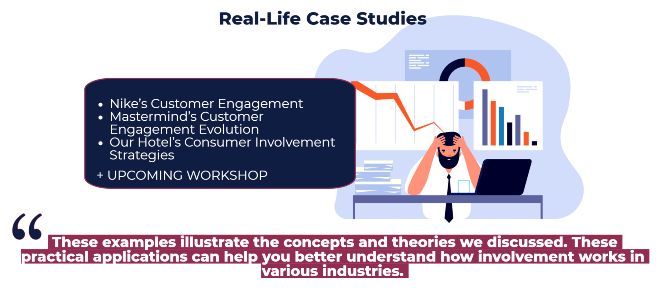
Real-Life Case Studies
These examples illustrate the concepts and theories we discussed. These practical applications can help you better understand how involvement works in various industries.
Nike’s Customer Engagement
Nike’s marketing campaigns and product customisation options, such as NikeID, involve customers in the design process. This engagement enhances customer loyalty and brand involvement.
NikeID is a customisation platform offered by Nike that allows customers to design their own sneakers and sportswear. Customers can choose from a range of customisable options, including colours, materials, and even personalised text or graphics. The platform offers a highly engaging and interactive experience for consumers who want unique and personalised products.
The “ISCTE Business School NikeID: Case Study on Footwear Customisation” delves into various aspects of NikeID, such as its digital platform, manufacturing paradigms, customisable parts of a sneaker, SWOT analysis, competitive analysis, fashion industry, behaviour trends, social media, technologies, and so much more.
It discusses how NikeID has leveraged consumer involvement to create a stronger connection between customers and the brand.
Mastermind’s Customer Engagement Evolution
Mastermind is a brand owned by Dean Graziosi who created a multimillion-dollar real estate business and became a Multiple NY Times best-selling Author.
When Dean wanted to enter a new industry in 2019, he partnered up with the legendary Tony Robbins – an American best-selling author, entrepreneur, philanthropist, life coach, and America’s #1 life and business strategist.
They created a training program – a step-by-step blueprint to help their students extract their current knowledge and transform this knowledge into products and services that can be sold in the marketplace – courses, training programs, masterminds, coaching and consulting services, books, events, and so much more.
The program was meant to be a huge success right from the start, mainly due to the enormous support Dean and Tony received from their limited number but highly-experienced external marketing partners – me included.
I was part of their journey that started in 2019 and I’ve been monitoring their actions ever since.
Now, here’s how the Mastermind brand evolved throughout the years.
The training program was an exceptional masterclass teaching newcomers how to use their knowledge and develop products and services that the world needs.
The training was combined with software that was helping students:
- Design and accept payments
- Build events
- Extract their wisdom and build their agendas
- Build web pages and sales funnels
- Use emails
- Track customers and sales
- Improve their efficiency with various tools and pre-made digital material
- Expand their capabilities with various integrations
The software was great but Dean soon realised that it was not enough as the marketplace is an ever-evolving landscape.
Something was missing.
Dean added a 3-day live in-person event, a summit to enhance his students’ experience and convert their involvement with the product from low to high.
He also offered access to his inner-circle private group of coaching.
However, as I already stated, the marketplace always changes as consumers’ behaviour changes.
Dean understood that the software although effective and result-oriented was a thing of the past. He also realised that the live summit and the inner-circle coaching group were adding tremendous value but still, there was room for improvement.
His customers were not highly involved with the product. The 3-day live event may had a long-lasting impact on the students but it could not keep the students motivated and highly involved with the product throughout the year.
Last year, Dean took things to a whole new level.
With the help of his team created the Mastermind platform, As he describes it, it’s the absolute tool and software to deliver your products, services, and offerings to the world.
Students now receive ongoing training and education sessions (beyond the main training masterclass) and support.
They have access to various tools to improve their entrepreneurial mindset, a very easy-to-use platform where they can upload their courses, training, workshops, or masterminds in literally minutes. Students can manage and run their whole business through this platform. On top of that, they have access to a worldwide directory that connects them with potential customers. Plus, there is an interactive community of like-minded students and business owners where they discuss privately or in groups anything related to their businesses.
Dean and Tony’s customers are now highly involved with the product all year long, due to the addition of the Mastermind platform.
This example shows the significance of transforming consumer involvement from low to high thus increasing brand loyalty and advocacy.
Related:
Do you need more real-life case studies? Let me know, so I can include a couple of them in the upcoming workshop.
Our Hotel’s Consumer Involvement Strategies
I’m also the co-owner of a small hotel along with my sister. It’s a family business.
Beyond providing excellent customer service (which always has been our #1 priority), that works as an engagement factor, increases brand loyalty and repeat visits, and fosters emotional and cognitive involvement, we were organising live events.
Small happenings like karaoke nights, music events with food and drink, and others.
Now, not every event is a huge success, but this strategy works and creates a bond with hotel guests. They have something to remember.
Plus, at some point, we closed a deal with an organisation (sort of non-profit), and we welcomed guests from a certain region in our country with their own cultural preferences.
We experimented with a new strategy that worked like crazy because it aligned perfectly with their social and cultural expectations.
Let me know if you want me to reveal this strategy in my upcoming workshop.
Live Events as a Consumer Involvement Strategy
Live events can be an effective way to increase consumer involvement. Live events provide consumers with a tangible and interactive experience with a brand or product. This interaction can create a deeper level of involvement and engagement, as consumers can see, touch, and experience the product or brand in a real-life context.
Live events can range from product launches, trade shows, and pop-up shops to interactive demonstrations and experiential marketing campaigns. These events allow consumers to connect with the brand on a personal level, which can enhance their understanding and emotional connection to the product or service.
Furthermore, live events often create memorable and shareable moments, which can lead to word-of-mouth marketing and social media buzz, further increasing consumer involvement and brand loyalty.
Implications for Marketing Strategies
Understanding how consumer involvement influences marketing strategies is essential for businesses to effectively engage their target audience. Here are some key points to consider:
- Tailored Communication: Consumer involvement necessitates personalised and tailored communication. Brands need to segment their audience effectively and deliver messages that resonate with each segment’s interests, needs, and preferences.
- Content Relevance: Highly involved consumers often seek valuable and relevant content. To cater to this, marketing strategies should focus on creating content that educates, entertains, or informs consumers, aligning with their interests.
- Loyalty Programs: Engaged consumers are more likely to participate in loyalty programs. Brands can use these programs strategically to incentivize repeat purchases and reward involvement, ultimately fostering long-term brand loyalty.
- Feedback Channels: Brands should establish robust feedback mechanisms to encourage consumer input. Customer feedback is invaluable for product improvement, service enhancements, and refining marketing strategies.
- Storytelling and Brand Narrative: Marketing strategies that incorporate storytelling and a compelling brand narrative can create deeper emotional connections with consumers. Engaged consumers often resonate with brands that share their values and mission.
- User-Generated Content: Involvement strategies should encourage user-generated content. Brands can leverage satisfied customers’ content, such as reviews, testimonials, and social media posts, to build trust and credibility.
- Omnichannel Presence: Businesses should maintain a consistent presence across various marketing channels to reach consumers wherever they prefer to engage. This may include social media, email marketing, content marketing, and in-store experiences.
- Sustainability and Social Responsibility: Brands that actively involve consumers in sustainability initiatives or social responsibility campaigns can create stronger connections. Marketing strategies should highlight these efforts and their alignment with consumer values.
- Data Analytics: Data-driven marketing plays a significant role in understanding consumer behaviour and preferences. Brands should use analytics to gain insights into consumer involvement and tailor strategies accordingly.
- Customer Experience: The overall customer experience should be seamless, enjoyable, and memorable. Marketers must ensure that consumer involvement is woven into every touchpoint, from browsing products online to receiving after-sales support.
- Localisation and Globalisation: Depending on the target audience, marketing strategies should balance localisation with global consistency. Understanding cultural nuances and adapting marketing messages can significantly impact consumer involvement in various regions.
- Innovation and Technology: Staying updated with emerging technologies and innovative marketing tactics is essential. Technological advancements often drive new avenues for consumer involvement, and brands should be prepared to leverage these.
These implications provide valuable insights for businesses looking to enhance their marketing strategies to better engage consumers. It will help your business navigate the evolving landscape of consumer involvement and adapt your approaches to foster stronger brand loyalty and positive relationships with your target audience.
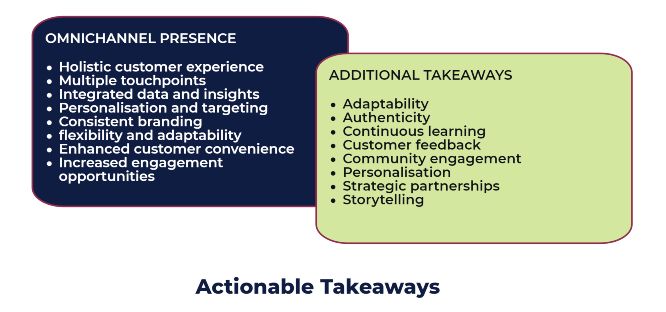
Actionable Takeaways
Omnichannel Presence
Omnichannel presence refers to a comprehensive and integrated approach that brands use to interact with consumers across various channels seamlessly. The goal is to provide a unified and consistent experience, regardless of whether the consumer is engaging with the brand online, offline, through social media, or in a physical store:
- Holistic Customer Experience: Omnichannel presence aims to create a holistic and cohesive customer experience. It recognises that consumers move fluidly between different channels and devices, and it seeks to ensure consistency in messaging, branding, and service quality.
- Multiple Touchpoints: Brands with omnichannel strategies utilise multiple touchpoints such as websites, mobile apps, social media, physical stores, and customer service channels. The idea is to meet consumers where they are and provide a seamless transition between these touchpoints.
- Integrated Data and Insights: Omnichannel strategies rely on integrated data systems that allow brands to gather insights from various channels. This data-driven approach helps in understanding consumer behaviour, preferences, and the effectiveness of different channels.
- Personalisation and Targeting: Omnichannel allows for personalised interactions with consumers based on their previous interactions, preferences, and behaviours. This level of personalisation enhances customer engagement and loyalty.
- Consistent Branding: Consistency in branding, messaging, and the overall brand image is a key aspect of omnichannel presence. Whether a consumer is browsing a website, visiting a physical store, or engaging on social media, the brand identity remains cohesive.
- Flexibility and Adaptability: Omnichannel strategies require flexibility to adapt to emerging technologies and changing consumer behaviours. Brands must be agile in incorporating new channels and technologies to stay relevant.
- Enhanced Customer Convenience: With an omnichannel approach, customers experience greater convenience. They can research products online, make purchases in-store, and seek customer support through various channels, creating a seamless and convenient journey.
- Increased Engagement Opportunities: By being present across multiple channels, brands open up more opportunities for customer engagement. Whether through social media interactions, loyalty programs, or exclusive online content, omnichannel strategies create diverse engagement points.
Overall, omnichannel presence is about meeting consumers where they are, providing a consistent and personalised experience, and leveraging integrated data to continuously improve and adapt to changing market dynamics.
Additional Takeaways
Beyond being omnichannel present in the current business landscape where consumers interact with brands across various channels, we should also consider these additional key points:
- Adaptability is Crucial: Consumer involvement strategies need to be adaptable to changing market trends, technological advancements, and consumer preferences. Brands that can pivot and evolve with the times are more likely to succeed.
- Authenticity Builds Trust: Authenticity in brand communication and actions fosters trust among consumers. Being transparent about values, practices, and product information contributes to a positive and engaged consumer base.
- Continuous Learning is Essential: In the rapidly evolving landscape, brands should emphasise continuous learning about their consumers, market dynamics, and emerging technologies. This learning mindset ensures relevance and sustained consumer engagement.
- Embrace Customer Feedback: Actively seek and incorporate customer feedback into your strategies. Customer opinions provide valuable insights that can guide product development, marketing efforts, and overall brand improvement.
- Community Engagement Matters: Building a sense of community around your brand fosters a deeper connection with consumers. Engage with your audience on social media, create forums for discussion, and encourage user-generated content to enhance community involvement.
- Personalisation Enhances Experiences: Tailoring products, services, and marketing efforts to individual consumer preferences creates a personalized experience. This level of customisation contributes to higher satisfaction and increased consumer loyalty.
- Strategic Partnerships can Amplify Impact: Collaborations and partnerships with other brands or influencers can extend your reach and impact. Choose partners aligned with your values and target audience for mutually beneficial outcomes.
- Storytelling Leaves a Lasting Impression: Crafting compelling brand narratives and storytelling contributes to a memorable brand image. Consumers connect emotionally with stories, making your brand more memorable and shareable.
These key takeaways reinforce the importance of adaptability, authenticity, continuous learning, community engagement, personalisation, strategic partnerships, and storytelling in building and maintaining strong consumer involvement.
Resume
In the world of marketing, understanding consumer involvement is the key to unlocking brand success. From delving into the depths of low and high involvement hierarchy to exploring the impact of cultural and ethical factors on your brand, you’ve journeyed through the intricate landscape of consumer involvement. You’ve witnessed the power of product placement and the role of emerging technologies like AR, VR, and AI in shaping the future of consumer engagement.
Related:
- An Intro to Consumer Behaviour
- Consumer Decision-Making Process: In-Depth Analysis & Book
- Decoding Consumer Perceptions: A Strategic Guide
- Decoding Consumer Behaviour: A Practical Journey Through 7 IDEALS
- Identify and Reach Your Target Audience: Comprehensive Guide
- Business Organisation and Administration: Thesis
- The Demanding Role of a Business Owner
- The Importance of Market Research
- The Strategic Significance of Marketing
- Everything Starts With Research
- The “7 IDEALS” Methodology
Now, it’s your turn to put your knowledge to the test. An interactive quiz awaits you, ready to assess your grasp of the concepts we’ve explored. By participating, you’ll gain insights into your understanding of consumer involvement, receive a custom video report with personalised recommendations for improvement, and, last but not least, a special surprise stands by.
So, why wait? Take the quiz and uncover your consumer involvement skills. It’s not just an assessment; it’s a journey towards mastering the art of engagement.
Ready to embark on this journey? Your adventure begins right here.
The Engagement Expert Quiz: How Strong Is Your Marketing Game?
🚀 Test Your Knowledge with This Quiz! 🚀
Welcome to an exciting quiz designed to challenge your skills and knowledge. But here’s the best part — it’s all about YOU!
🌟 Why Take This Quiz?
This quiz is a fun way to test your expertise and learn a bit more about yourself. After all, it’s not just a quiz; it’s a personalised journey to discover your strengths and uncover areas for improvement. Plus, there’s a special surprise waiting for you at the end!
📊 Get Your Personalised Score
Once you complete the quiz, you’ll receive your personalised score. This score reflects your current level of expertise. But it doesn’t stop there — you’ll also receive a custom 30-second video from me explaining how you can improve your skills. It’s like a mini-coaching session, just for you!
🔐 Your Privacy Matters
We respect your privacy, and your trust is our priority. When you complete the quiz, we’ll ask for your name and email address. Don’t worry; we won’t flood your inbox with unwanted emails. Your email will be used solely to send you the results of the quiz and your personalised video. You are not subscribing to the newsletter. Your data is safe with WebMarketSupport.
✨ Discover the Next Step
Once you complete the quiz, beyond receiving your custom report, there’s a huge surprise waiting.
Are you ready to dive in? Let’s get started!
The Engagement Expert Quiz: How Strong Is Your Marketing Game?

Tasos Perte Tzortzis
Business Organisation & Administration, Marketing Consultant, Creator of the "7 Ideals" Methodology
Although doing traditional business offline since 1992, I fell in love with online marketing in late 2014 and have helped hundreds of brands sell more of their products and services. Founder of WebMarketSupport, Muvimag, Summer Dream.
Reading, arts, science, chess, coffee, tea, swimming, Audi, and family comes first.
References/Citations
- TheAssociationForConsumerResearch: The Dimensions of Brand Consistent Behavior
- ResearchGate: Measuring Consumer Involvement Profiles
- ResearchGate: Consumer Involvement: A New Perspective
- ScientificResearch: Hierarchical Value Maps of Smart Phones, Portal Sites, and Social Network Services Based on User Involvement
- AtlanticPress: The Luxury Brand Transcultural Strategies in Contemporary Society: Take Louis Vuitton as an Example (pdf)
- EmeraldInsight: The impact of brand love on brand loyalty: the moderating role of self-esteem, and social influences
- VoyMedia: Apple Marketing Strategy
- YourStory: Apple’s Social Media Strategy
- SageJournals: Ethics and Target Marketing: The Role of Product Harm and Consumer Vulnerability
- ArkansasTechUniversity: Marketing Regulation and Consumer Behavior: Ethical Issues in
Marketing to Children (pdf) - SpringerLink: Gamification and customer experience in online retail: a qualitative study focusing on ethical perspective
- LinkedIn: Case studies and examples of successful international business ventures.
- EmeraldInsight: Consumer behavior in global markets: the A‐B‐C‐D paradigm and its application to eastern Europe and the Third World
- Sciendo: Cross-Cultural Variations in Consumer Behavior: A Literature Review of International Studies
- Taylor&FrancisOnline: Cross-Cultural Consumer Behavior: A Review of Research Findings
- ResearchGate: Connecting to Global Markets – Challenges and Opportunities: Case Studies Presented by WTO Chair-Holders
- IvyPanda: Burberry: Global Branding Challenges and Strategies Report
- Inc: 20 Epic Fails in Global Branding
- Linkedin: 17 Global Brand Failures
- HarvardBusinessReview: Beware the Pitfalls of Global Marketing
- ResearchGate: Manipulating Message Involvement in Advertising Research
- WileyOnlineLibrary: Program content and advertising effectiveness: A test of the congruity hypothesis for cognitive and affective sources of involvement
- YouTube: Apple 1984 Super Bowl Commercial Introducing Macintosh Computer
- YouTube: ‘Dream Crazy’ – Colin Kaepernick Nike Ad 2019
- YouTube: BMW Films – The Hire – Ambush
- YouTube: Old Spice | The Man Your Man Could Smell Like
- YouTube: DollarShaveClub.com – Our Blades Are F***ing Great
- YouTube: GEICO Hump Day Camel Commercial Happier than a Camel on Wednesday
- OxfordAcademic: Passive Learning From Television
- BrockUniversity: Crisis in Social Psychology: Some Remarks Towards Breaking Through the Crisis
- SimplyPsychology: Elaboration Likelihood Model Of Persuasion
- ResearchGate: Consumers Involvement Profiles: New Empirical Result
- JSTOR: A Multiattribute Model of Consumer Choice during Product Learning
- SimplyPsychology: Theory Of Reasoned Action (Fishbein And Ajzen, 1975)
- NationalLibraryOfMedicine: Using The Theory Of Planned Behaviour To Determine The Condom Use Behaviour Among College Students
- TheoryHub: Flow Theory
- NationalLibraryOfMedicine: The relation of rational and experiential information processing styles to personality, basic beliefs, and the ratio-bias phenomenon
- PracticalPsychology: Stimulus Response Theory (Thorndike’s Research + Examples)
- Philo-Notes: Watson’s Theory Of Behaviourism: Key Concepts
- WichitaStateUniversity: Cognitive Learning Theory
- PsychologyDiscussion: Tolman’s Sign Theory of Learning | Education
- StructuralLearning: Skinner’s Theories
- BCCampusOpenPublishing: Learning by Association: Classical Conditioning
- ResearchGate: Classical Conditioning of Consumer Attitudes: 4 Experiments In An Advertising Context
- JSTOR: The effects of advertisement picture likeability on information search and brand choice
- AmericanPsychologyAssociation: How do young children learn to be consumers? A script-processing approach
- JSTOR: An Empirical Analysis of the Relationship between Brand Loyalty and Consumer Price Elasticity
- ScientificResearch: An Empirical Study of Perceived Factors Affecting Customer Satisfaction to Re-Purchase Intention in Online Stores in China
- AppifyCommerce: Real-World Success Stories: Brands Leveraging AR for eCommerce Growth
- Vrowl: The 22 best examples of how companies use virtual reality for training
- Lineate: 3 Ways Amazon Uses AI to Make Product Recommendations
- YouTube: Say Hej to IKEA Place
- YouTube: Audi Virtual Training Car
- YouTube: How Amazon Uses AI To Sell You More And More Products
- ReatilDive: Sephora’s Virtual Artist brings augmented reality to large beauty audience
- Braze: Sephora SEA Increases Augmented Reality Feature Adoption Rates by 28%
- DigiDay: Lowe’s is using VR and AR to get people into stores
- Medium: Case Study: How Netflix Uses AI to Personalize Content Recommendations and Improve Digital Marketing
- LXAHub: Three Creepy Examples of Personalisation, and How to Avoid The Trap
- RobbenMedia: 3 Examples Of Poor Brand Consistency’s Destruction
- Time: The 20 Most Successful Technology Failures of All Time
- StudioNoel: Leading The Green Revolution: The Best Sustainability Branding Examples
- StepWise: 7 amazing success stories proving that Data Science is essential for your business
- PunchDrunkDigital: Examples of Digital Advertising and Traditional Media Partnering for Great Success
- WolfestoneGroup: Recession Success Stories: What 3 Major Brands Taught Us About Recession-Proofing Your Business
- MarketSplash: Building Brand Trust: 6 Actionable Tips + 12 Great Examples
- CrowdFire: 5 Brands Who Gave Amazing Responses to Negative Tweets
- InformationOverloadResearchGroup: Intel’s War On Information Overload: A Case Study (pdf)
- Taylor&FrancisOnline: Negative customer engagement in emerging markets: cognitive dimension
- ScienceDirect: When consumers doubt, Watch out! The role of CSR skepticism
- OnlineDasher: 10+ Customer Engagement Statistics & Data (Latest Numbers)
- OutGrow: Customer Engagement Statistics In 2023
- GWI: Social Browsers Engage with Brands
- InfoCast: The Omnichannel Experience Consumers Are Craving
- KonnectInsights: Online Reputation Management for Small Businesses
- SocialPilot: 100+ Surprising Video Marketing Statistics You Should Know in 2023
- George I. Siomkos, Ph. D. Macedonia University Marketing Dept.: Consumer Behaviour and Marketing Strategy (Book)
- ISCTEBusinessSchool: NikeID: Case Study On Footwear Customisation (pdf)
- Mastermind: A Platform That Supports Knowledge Brokers
- WebMarketSupport: The Demanding Role Of A Business Owner
- WebMarketSupport: The Importance Of Market Research
- WebMarketSupport: Project Next Review: Mastermind World Summit
- WebMarketSupport: Knowledge Broker Blueprint Review
- WebMarketSupport: How To Drastically Improve Your Customer Service
- WebMarketSupport: 5 Tips for Creating a Recognizable Online Presence
- WebMarketSupport: Identify & Reach Your Target Audience | Comprehensive Guide
- WebMarketSupport: Guerrilla Marketing – Ultimate Weapon If Done Right
- WebMarketSupport: 25+ Effective Strategies To Market & Grow Your Podcast
- WebMarketSupport: 10 Ways Mobile Website Development Can Help Your Brand
- WebMarketSupport: Launching Products Like a Pro
- WebMarketSupport: 5 Ways To Generate Leads Through Video Marketing
- WebMarketSupport: What is Affiliate Marketing
- WebMarketSupport: How Influencer Marketing Impacts Business Growth
- WebMarketSupport: The Future of Email Marketing: How to Optimize for Mobile Devices
- WebMarketSupport: 23 Solid Reasons That Prove Content Marketing Can Boost Your Business
- WebMarketSupport: Introduction To Consumer Behaviour
- WebMarketSupport: Consumer Decision-Making Process
- WebMarketSupport: The “7 IDEALS” Methodology
MARKETING | ADVERTISING | SALES
-
Decrypting Consumer Behaviour: A Practical Journey Through 7 IDEALS
-
Short-Term Goals: The Building Blocks of Effective Marketing Plans
-
Mastering the Art of Search Visibility: A Comprehensive Guide
-
Boosting Conversions in 2023 and Beyond: 7 Types of Content You Should Use
- Zero-Party, First-Party, Second-Party, Third-Party Data
-
The Ultimate Guide to Use an iPad Survey to Grow Your Business
- 6 Clever Ways To Use Instagram For Customer Retention
-
Emotional Marketing Examples | Scientifically Proven To Sway
- How Influencer Marketing Impacts Business Growth
- Identify and reach your target audience - comprehensive guide
- Guerrilla marketing - ultimate weapon if done right
- What is branding in business and how to build a brand
- Direct response marketing - all you need to know
- Does product appearance matter? a story, research, and more
-
23 Solid Reasons That Prove Content Marketing Can Boost Your Business
- Don't push customers to buy
- How to Build a Content Marketing Campaign for your Next Event
- Key Coupon Marketing Strategies To Accelerate Sales
-
The Power Of Video Marketing In A Competitive Business World
-
Marketing Ideas For Photographers – How To Boost Your Portfolio
-
How Artificial Intelligence (AI) Is Changing Social Media Marketing
-
The Future of Email Marketing: How to Optimize for Mobile Devices
- 11 common blogging mistakes that cost you a fortune
- 5 Tips for Creating a Recognizable Online Presence
- Expertise, Authority, and Trust In SEO
-
Why Search Intent Matters For SEO And How To Optimize Your Website
-
Why Well-Established Brands Keep Spending Money On Advertising
-
6 Powerful Suggestions For Writing A Successful Shopify Description
-
5 Effective Ways To Captivate Potential Clients On Social Media
- Ways To Sell Unwanted Gift Cards: Save Time and Money
-
How Can you Make Money with Blogging? – Here are 9 Popular Ways
-
Inbound vs Outbound Marketing Techniques – On the Battlefield
-
New Customer Needs Resulting in a Modern Marketing Definition
-
Low Hanging Fruit Definition – Best Keywords To Get Ranked Sooner
-
How To Promote Your Website Business Offline and Gain Exposure
-
Infographic – How To Advertise Your Business Online For Free
-
Unmasking Black Hat SEO Common Traps, Risks & Ethical Alternatives
Entrepreneurship
-
Legal Landscape of AI: Insights, Strategies, and Future Trends
- Business Organisation & Administration: Thesis
- The Demanding Role of a Business Owner: Leading Towards Success
- Launch Your Wholesale Cellphone Empire: A Thrilling Start-Up Adventure!
- 5 Ways Customer Education Can Help Your Business
-
How Tourism Brands Can Show Gratitude In A Period Of Social Distancing
- Build Strong Relationships With Remote Employees
- Entrepreneurship Meaning: Is Not Just Running Businesses
- Logic vs imagination in entrepreneurship
- Should I become an entrepreneur?
- What drives me as an entrepreneur - a personal story
- Embrace failure and learn from it
- 12 Powerful Productivity Hacks For Business Owners
- Most people don't succeed, but you can be the exception
- Why a coffee shop is not always a good business idea
- 10 Ways To Know If You Need A Real Estate Agent
-
Simple & Effective Customer Loyalty Strategies You Can Use Today!
- A Friend’s Story As A Family Owned Business Problems Example
-
Why Psychometric Evaluation Tests Are Essential For Your Hiring Process
- How to Choose the Best Requirements Management Solution
- 7 Steps to Prepare Your Business for the AI and Automation Revolution
-
How A Coworking Space Can Turn Your Organization Into Success?
-
How a Company Lost a Client for €15 deal – Bad Customer Service Example
- Lego Movie Meaning. Could You be the “One”?
-
Should you Send ID & Address Verification Documents to Biz Opp Sites?
- PTC-GPT Sites Real-Time Monitoring
-
“Trendy” Revenue Sharing Explained | How “You” Become a Product!
3rd-Party Cookies
Google’s decision to not deprecate third-party cookies in Chrome means brands should continue focusing on first-party and zero-party data strategies, prioritizing consumer privacy and consent. While the adtech industry has already been shifting towards cookieless solutions, this move highlights the importance of brands adapting to privacy-friendly alternatives and data collaboration. Brands are encouraged to collect data transparently and rely on direct consumer relationships to enhance marketing effectiveness.
Free Training for Traders
MarketLogica: Only 500 seats are available.
Create Videos with Text Prompts
InVideo: Publish-ready videos with zero video creation skills. Type any topic and invideo AI creates a video with script, visuals, subtitles, voiceover & music.
Smart Web Solutions For Your Small Business
HostPapa: Hosting, website builder, domains, email and office, security. A privately-owned company headquartered in Burlington, Ontario. 11 more locations. 51-200 employees, founded in 2006.
TOP CONTRIBUTORS
We honoured the 6 first names, and now we will return with an updated version. More rewards are coming. Stay tuned!
TOP Quote
Slavery was legal. Segregation was legal. War is legal. Never use legality as a guide to morality.
A REVOLUTIONARY WAY of doing business in the "AFFILIATE INDUSTRY"
🚀 Affiliate Advantage Alliance: Master successful affiliate promotions with an affordable subscription and together, let’s change the affiliate industry that is suffering right now (for aspiring entrepreneurs and brands that want to hire affiliates).
Stay tuned!
Read More
Latest Posts
Knowledge Industry: Live Challenge (incoming)
Let’s explore the wonderful and unique industry of collectible coins by developing an information product which will set the base for innovation.
Affiliate Advantage Alliance
How Much Money Is Enough? Formula for Balance
The myth of endless wealth, the complexity of human happiness, research, studies, the wealthiest individuals, the entrepreneurial journey, the future, and a formula for balanced wealth-seeking and meaningful life.
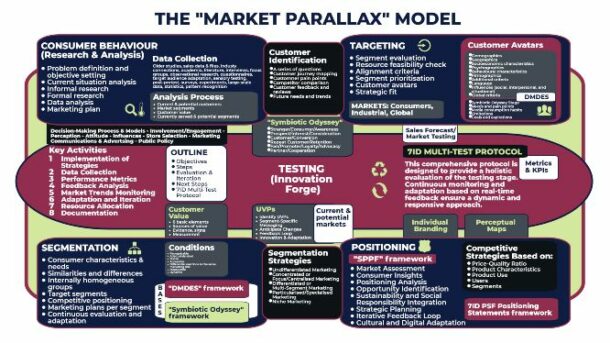
Decrypting ConsumerBehaviour
Enter the groundbreaking "Market Parallax" Model.
We explore consumer behaviour by employing a diverse array of techniques, including research methodologies, data collection and analysis, market segmentation, targeted approaches, product positioning, and trial testing.
Through these marketing lenses, we unravel the intricate field of consumer behaviour and explore avenues for influencing it judiciously.
Download the 31-page INFOGRAPHIC-BOOK to understand how consumers act on a deeper level and get closer to influencing their decisions with your marketing initiatives.
*Check your email for the password that gives you access to the membership area.












0 Comments